P/E Ratio Analysis: Evaluating Share Values of Select Companies
VerifiedAdded on 2023/06/10
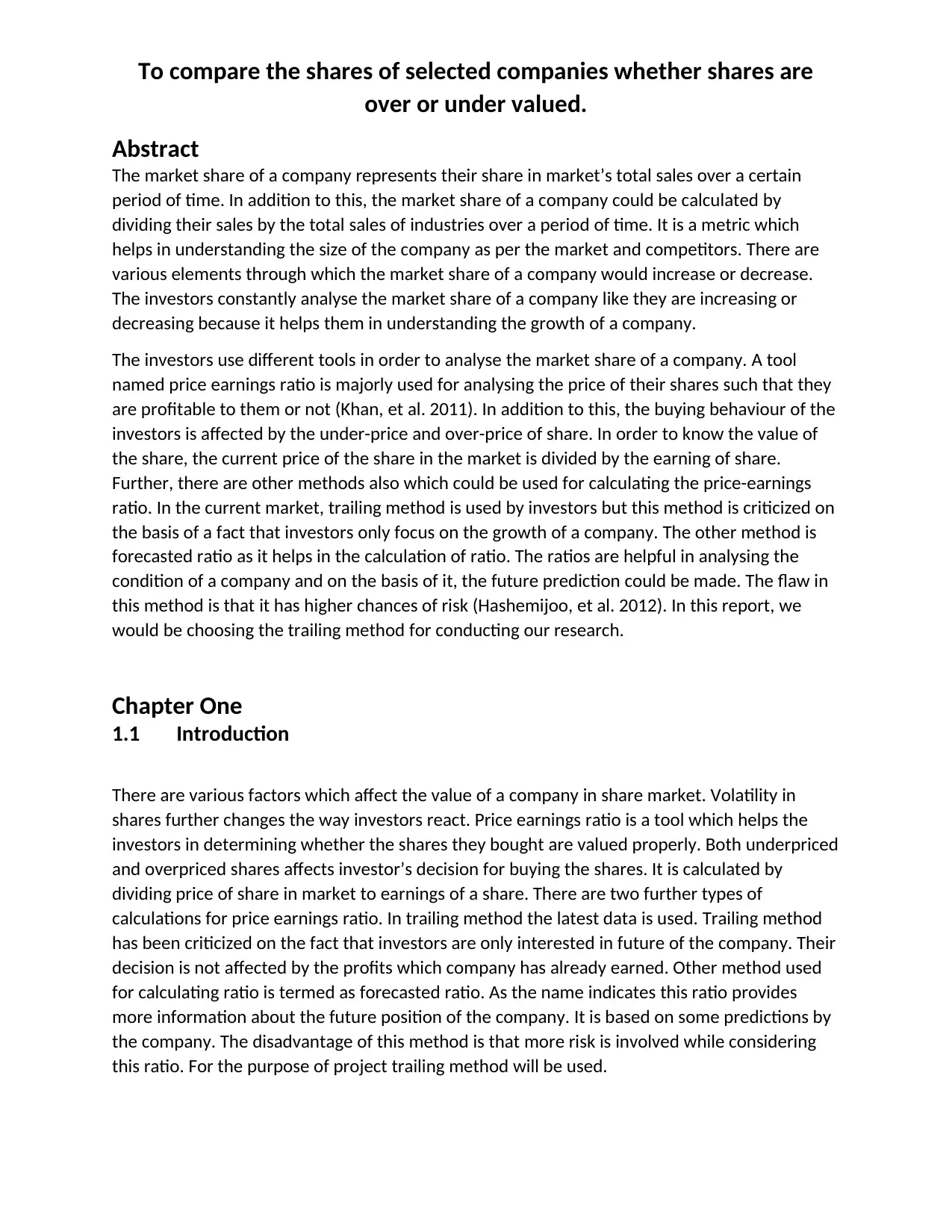
over or under valued.
Abstract
The market share of a company represents their share in market’s total sales over a certain
period of time. In addition to this, the market share of a company could be calculated by
dividing their sales by the total sales of industries over a period of time. It is a metric which
helps in understanding the size of the company as per the market and competitors. There are
various elements through which the market share of a company would increase or decrease.
The investors constantly analyse the market share of a company like they are increasing or
decreasing because it helps them in understanding the growth of a company.
The investors use different tools in order to analyse the market share of a company. A tool
named price earnings ratio is majorly used for analysing the price of their shares such that they
are profitable to them or not (Khan, et al. 2011). In addition to this, the buying behaviour of the
investors is affected by the under-price and over-price of share. In order to know the value of
the share, the current price of the share in the market is divided by the earning of share.
Further, there are other methods also which could be used for calculating the price-earnings
ratio. In the current market, trailing method is used by investors but this method is criticized on
the basis of a fact that investors only focus on the growth of a company. The other method is
forecasted ratio as it helps in the calculation of ratio. The ratios are helpful in analysing the
condition of a company and on the basis of it, the future prediction could be made. The flaw in
this method is that it has higher chances of risk (Hashemijoo, et al. 2012). In this report, we
would be choosing the trailing method for conducting our research.
Chapter One
1.1 Introduction
There are various factors which affect the value of a company in share market. Volatility in
shares further changes the way investors react. Price earnings ratio is a tool which helps the
investors in determining whether the shares they bought are valued properly. Both underpriced
and overpriced shares affects investor’s decision for buying the shares. It is calculated by
dividing price of share in market to earnings of a share. There are two further types of
calculations for price earnings ratio. In trailing method the latest data is used. Trailing method
has been criticized on the fact that investors are only interested in future of the company. Their
decision is not affected by the profits which company has already earned. Other method used
for calculating ratio is termed as forecasted ratio. As the name indicates this ratio provides
more information about the future position of the company. It is based on some predictions by
the company. The disadvantage of this method is that more risk is involved while considering
this ratio. For the purpose of project trailing method will be used.
Paraphrase This Document
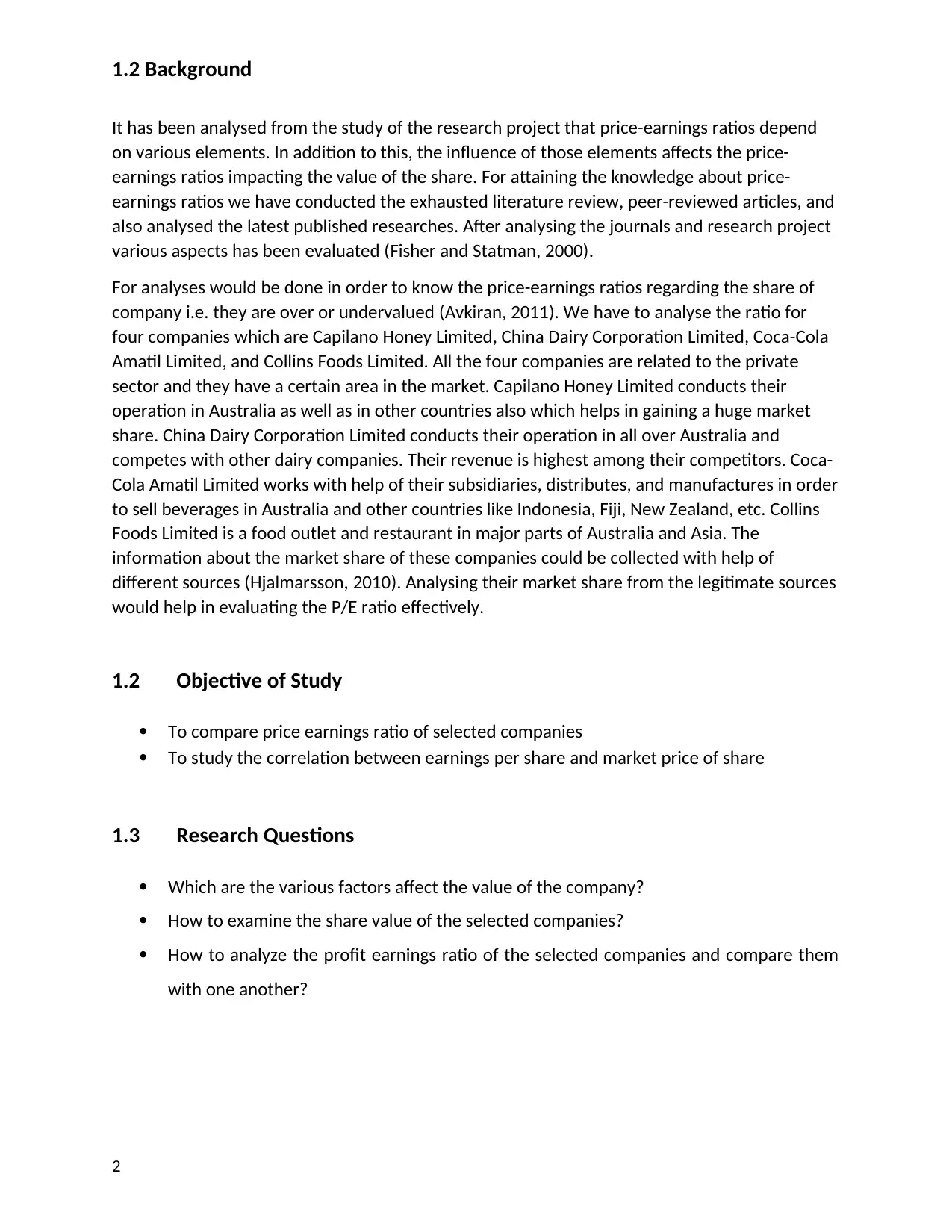
It has been analysed from the study of the research project that price-earnings ratios depend
on various elements. In addition to this, the influence of those elements affects the price-
earnings ratios impacting the value of the share. For attaining the knowledge about price-
earnings ratios we have conducted the exhausted literature review, peer-reviewed articles, and
also analysed the latest published researches. After analysing the journals and research project
various aspects has been evaluated (Fisher and Statman, 2000).
For analyses would be done in order to know the price-earnings ratios regarding the share of
company i.e. they are over or undervalued (Avkiran, 2011). We have to analyse the ratio for
four companies which are Capilano Honey Limited, China Dairy Corporation Limited, Coca-Cola
Amatil Limited, and Collins Foods Limited. All the four companies are related to the private
sector and they have a certain area in the market. Capilano Honey Limited conducts their
operation in Australia as well as in other countries also which helps in gaining a huge market
share. China Dairy Corporation Limited conducts their operation in all over Australia and
competes with other dairy companies. Their revenue is highest among their competitors. Coca-
Cola Amatil Limited works with help of their subsidiaries, distributes, and manufactures in order
to sell beverages in Australia and other countries like Indonesia, Fiji, New Zealand, etc. Collins
Foods Limited is a food outlet and restaurant in major parts of Australia and Asia. The
information about the market share of these companies could be collected with help of
different sources (Hjalmarsson, 2010). Analysing their market share from the legitimate sources
would help in evaluating the P/E ratio effectively.
1.2 Objective of Study
To compare price earnings ratio of selected companies
To study the correlation between earnings per share and market price of share
1.3 Research Questions
Which are the various factors affect the value of the company?
How to examine the share value of the selected companies?
How to analyze the profit earnings ratio of the selected companies and compare them
with one another?
2
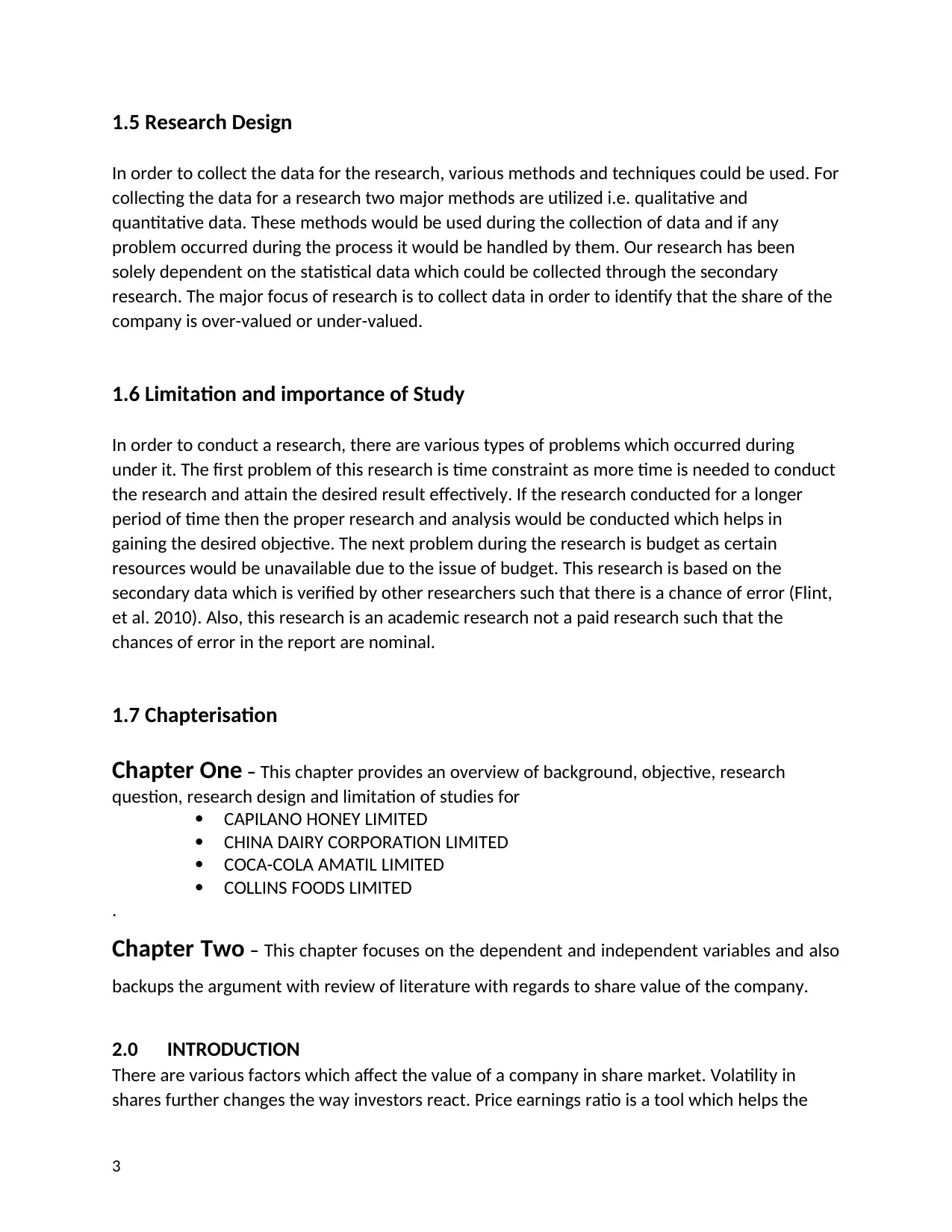
In order to collect the data for the research, various methods and techniques could be used. For
collecting the data for a research two major methods are utilized i.e. qualitative and
quantitative data. These methods would be used during the collection of data and if any
problem occurred during the process it would be handled by them. Our research has been
solely dependent on the statistical data which could be collected through the secondary
research. The major focus of research is to collect data in order to identify that the share of the
company is over-valued or under-valued.
1.6 Limitation and importance of Study
In order to conduct a research, there are various types of problems which occurred during
under it. The first problem of this research is time constraint as more time is needed to conduct
the research and attain the desired result effectively. If the research conducted for a longer
period of time then the proper research and analysis would be conducted which helps in
gaining the desired objective. The next problem during the research is budget as certain
resources would be unavailable due to the issue of budget. This research is based on the
secondary data which is verified by other researchers such that there is a chance of error (Flint,
et al. 2010). Also, this research is an academic research not a paid research such that the
chances of error in the report are nominal.
1.7 Chapterisation
Chapter One – This chapter provides an overview of background, objective, research
question, research design and limitation of studies for
CAPILANO HONEY LIMITED
CHINA DAIRY CORPORATION LIMITED
COCA-COLA AMATIL LIMITED
COLLINS FOODS LIMITED
.
Chapter Two – This chapter focuses on the dependent and independent variables and also
backups the argument with review of literature with regards to share value of the company.
2.0 INTRODUCTION
There are various factors which affect the value of a company in share market. Volatility in
shares further changes the way investors react. Price earnings ratio is a tool which helps the
3
⊘ This is a preview!⊘
Do you want full access?
Subscribe today to unlock all pages.

Trusted by 1+ million students worldwide
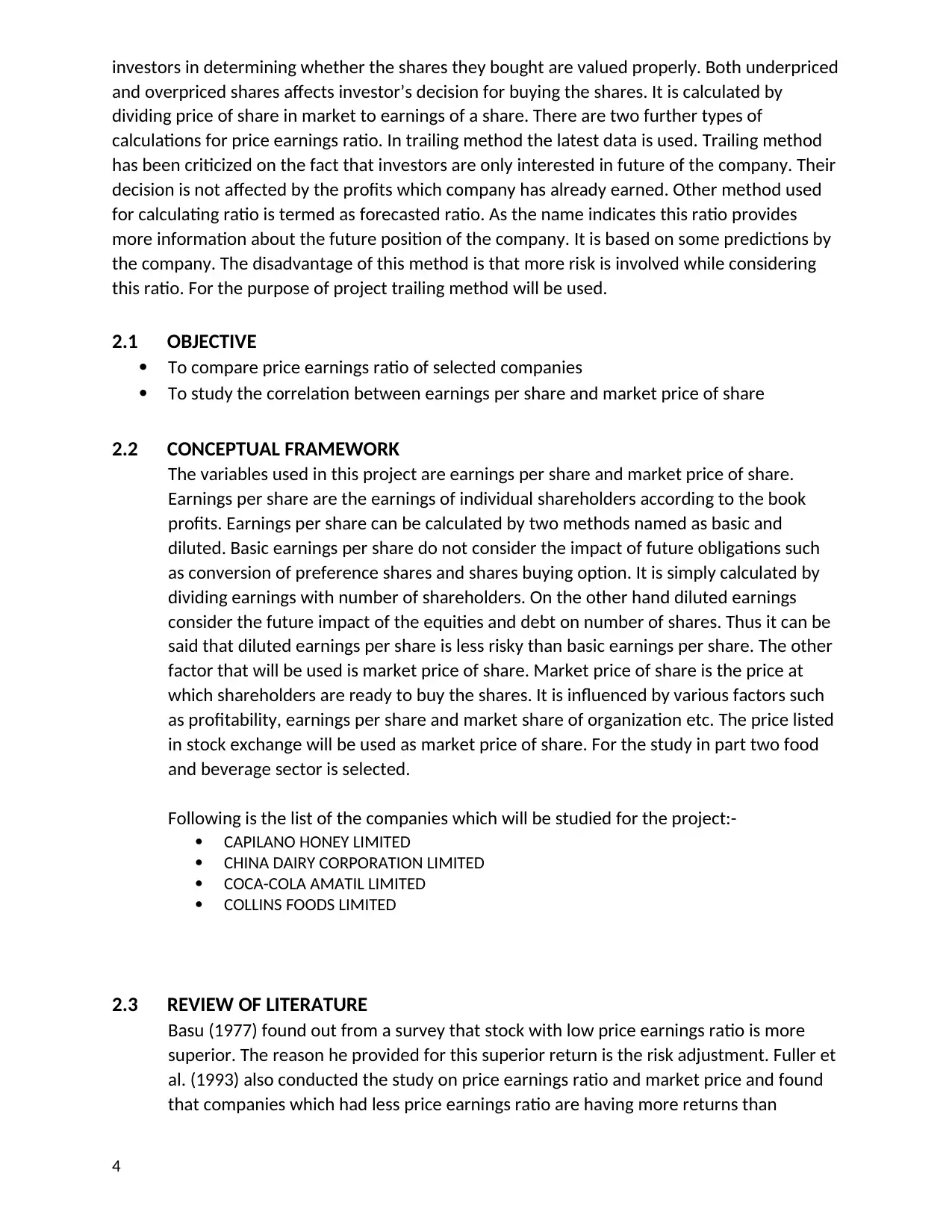
and overpriced shares affects investor’s decision for buying the shares. It is calculated by
dividing price of share in market to earnings of a share. There are two further types of
calculations for price earnings ratio. In trailing method the latest data is used. Trailing method
has been criticized on the fact that investors are only interested in future of the company. Their
decision is not affected by the profits which company has already earned. Other method used
for calculating ratio is termed as forecasted ratio. As the name indicates this ratio provides
more information about the future position of the company. It is based on some predictions by
the company. The disadvantage of this method is that more risk is involved while considering
this ratio. For the purpose of project trailing method will be used.
2.1 OBJECTIVE
To compare price earnings ratio of selected companies
To study the correlation between earnings per share and market price of share
2.2 CONCEPTUAL FRAMEWORK
The variables used in this project are earnings per share and market price of share.
Earnings per share are the earnings of individual shareholders according to the book
profits. Earnings per share can be calculated by two methods named as basic and
diluted. Basic earnings per share do not consider the impact of future obligations such
as conversion of preference shares and shares buying option. It is simply calculated by
dividing earnings with number of shareholders. On the other hand diluted earnings
consider the future impact of the equities and debt on number of shares. Thus it can be
said that diluted earnings per share is less risky than basic earnings per share. The other
factor that will be used is market price of share. Market price of share is the price at
which shareholders are ready to buy the shares. It is influenced by various factors such
as profitability, earnings per share and market share of organization etc. The price listed
in stock exchange will be used as market price of share. For the study in part two food
and beverage sector is selected.
Following is the list of the companies which will be studied for the project:-
CAPILANO HONEY LIMITED
CHINA DAIRY CORPORATION LIMITED
COCA-COLA AMATIL LIMITED
COLLINS FOODS LIMITED
2.3 REVIEW OF LITERATURE
Basu (1977) found out from a survey that stock with low price earnings ratio is more
superior. The reason he provided for this superior return is the risk adjustment. Fuller et
al. (1993) also conducted the study on price earnings ratio and market price and found
that companies which had less price earnings ratio are having more returns than
4
Paraphrase This Document
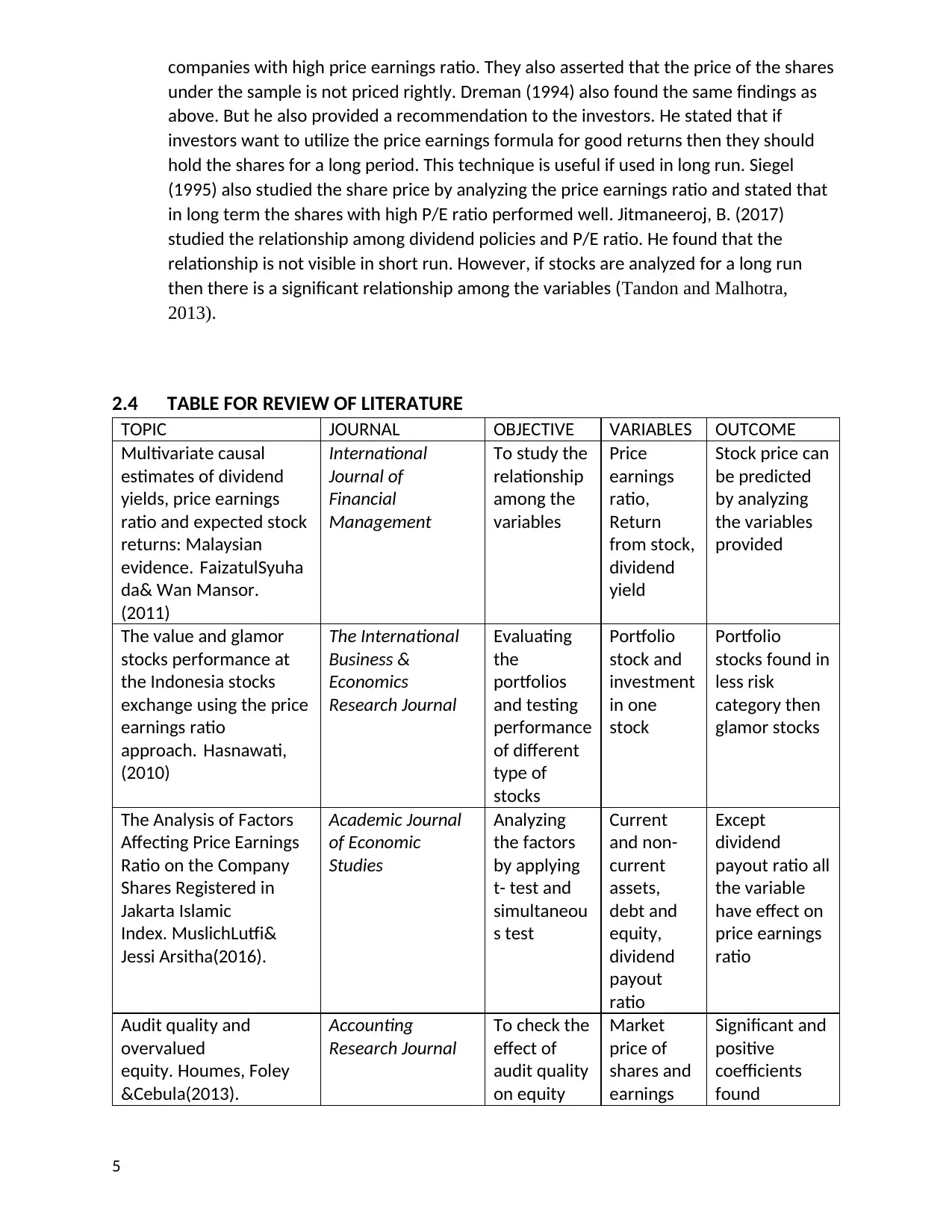
under the sample is not priced rightly. Dreman (1994) also found the same findings as
above. But he also provided a recommendation to the investors. He stated that if
investors want to utilize the price earnings formula for good returns then they should
hold the shares for a long period. This technique is useful if used in long run. Siegel
(1995) also studied the share price by analyzing the price earnings ratio and stated that
in long term the shares with high P/E ratio performed well. Jitmaneeroj, B. (2017)
studied the relationship among dividend policies and P/E ratio. He found that the
relationship is not visible in short run. However, if stocks are analyzed for a long run
then there is a significant relationship among the variables (Tandon and Malhotra,
2013).
2.4 TABLE FOR REVIEW OF LITERATURE
TOPIC JOURNAL OBJECTIVE VARIABLES OUTCOME
Multivariate causal
estimates of dividend
yields, price earnings
ratio and expected stock
returns: Malaysian
evidence. FaizatulSyuha
da& Wan Mansor.
(2011)
International
Journal of
Financial
Management
To study the
relationship
among the
variables
Price
earnings
ratio,
Return
from stock,
dividend
yield
Stock price can
be predicted
by analyzing
the variables
provided
The value and glamor
stocks performance at
the Indonesia stocks
exchange using the price
earnings ratio
approach. Hasnawati,
(2010)
The International
Business &
Economics
Research Journal
Evaluating
the
portfolios
and testing
performance
of different
type of
stocks
Portfolio
stock and
investment
in one
stock
Portfolio
stocks found in
less risk
category then
glamor stocks
The Analysis of Factors
Affecting Price Earnings
Ratio on the Company
Shares Registered in
Jakarta Islamic
Index. MuslichLutfi&
Jessi Arsitha(2016).
Academic Journal
of Economic
Studies
Analyzing
the factors
by applying
t- test and
simultaneou
s test
Current
and non-
current
assets,
debt and
equity,
dividend
payout
ratio
Except
dividend
payout ratio all
the variable
have effect on
price earnings
ratio
Audit quality and
overvalued
equity. Houmes, Foley
&Cebula(2013).
Accounting
Research Journal
To check the
effect of
audit quality
on equity
Market
price of
shares and
earnings
Significant and
positive
coefficients
found
5
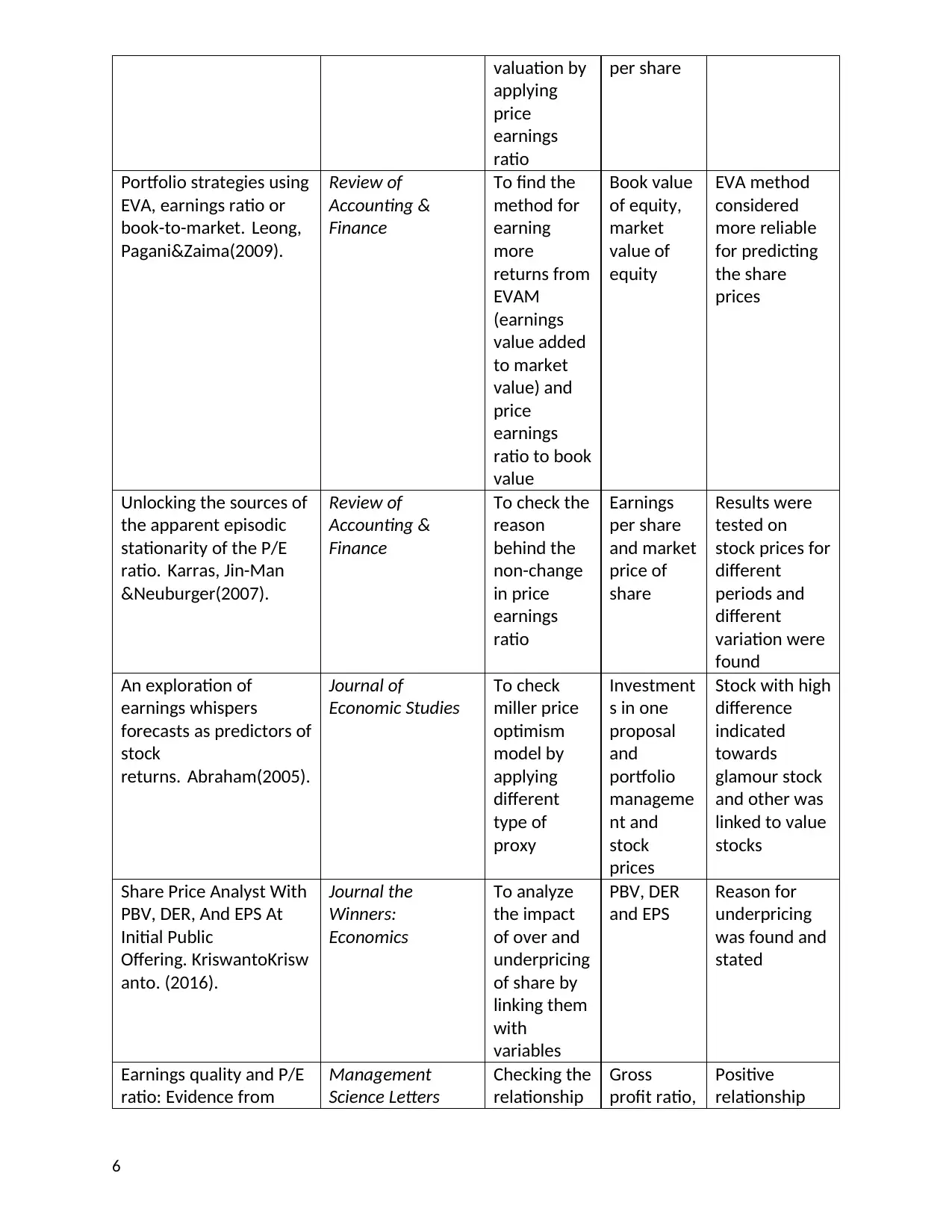
applying
price
earnings
ratio
per share
Portfolio strategies using
EVA, earnings ratio or
book-to-market. Leong,
Pagani&Zaima(2009).
Review of
Accounting &
Finance
To find the
method for
earning
more
returns from
EVAM
(earnings
value added
to market
value) and
price
earnings
ratio to book
value
Book value
of equity,
market
value of
equity
EVA method
considered
more reliable
for predicting
the share
prices
Unlocking the sources of
the apparent episodic
stationarity of the P/E
ratio. Karras, Jin-Man
&Neuburger(2007).
Review of
Accounting &
Finance
To check the
reason
behind the
non-change
in price
earnings
ratio
Earnings
per share
and market
price of
share
Results were
tested on
stock prices for
different
periods and
different
variation were
found
An exploration of
earnings whispers
forecasts as predictors of
stock
returns. Abraham(2005).
Journal of
Economic Studies
To check
miller price
optimism
model by
applying
different
type of
proxy
Investment
s in one
proposal
and
portfolio
manageme
nt and
stock
prices
Stock with high
difference
indicated
towards
glamour stock
and other was
linked to value
stocks
Share Price Analyst With
PBV, DER, And EPS At
Initial Public
Offering. KriswantoKrisw
anto. (2016).
Journal the
Winners:
Economics
To analyze
the impact
of over and
underpricing
of share by
linking them
with
variables
PBV, DER
and EPS
Reason for
underpricing
was found and
stated
Earnings quality and P/E
ratio: Evidence from
Management
Science Letters
Checking the
relationship
Gross
profit ratio,
Positive
relationship
6
⊘ This is a preview!⊘
Do you want full access?
Subscribe today to unlock all pages.

Trusted by 1+ million students worldwide
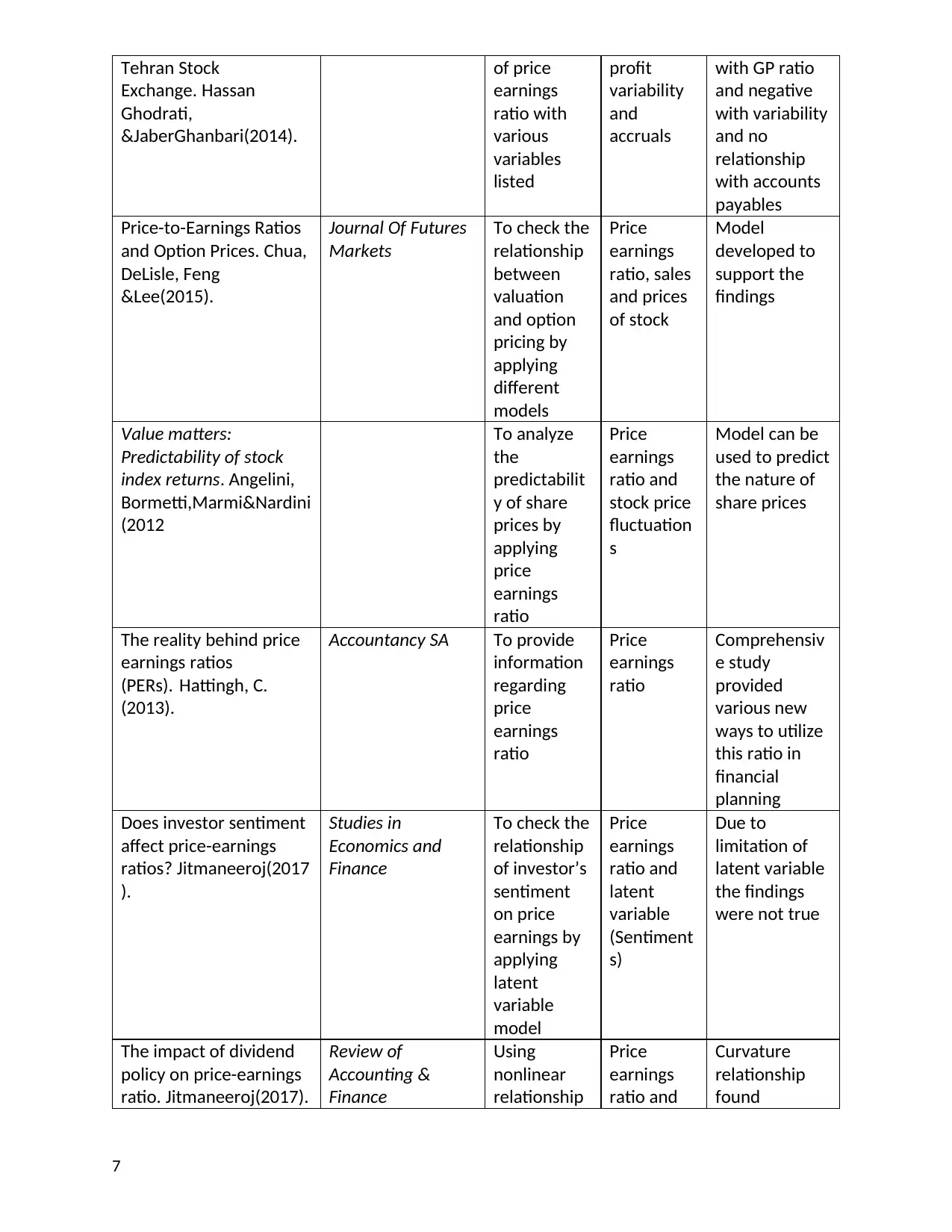
Exchange. Hassan
Ghodrati,
&JaberGhanbari(2014).
of price
earnings
ratio with
various
variables
listed
profit
variability
and
accruals
with GP ratio
and negative
with variability
and no
relationship
with accounts
payables
Price-to-Earnings Ratios
and Option Prices. Chua,
DeLisle, Feng
&Lee(2015).
Journal Of Futures
Markets
To check the
relationship
between
valuation
and option
pricing by
applying
different
models
Price
earnings
ratio, sales
and prices
of stock
Model
developed to
support the
findings
Value matters:
Predictability of stock
index returns. Angelini,
Bormetti,Marmi&Nardini
(2012
To analyze
the
predictabilit
y of share
prices by
applying
price
earnings
ratio
Price
earnings
ratio and
stock price
fluctuation
s
Model can be
used to predict
the nature of
share prices
The reality behind price
earnings ratios
(PERs). Hattingh, C.
(2013).
Accountancy SA To provide
information
regarding
price
earnings
ratio
Price
earnings
ratio
Comprehensiv
e study
provided
various new
ways to utilize
this ratio in
financial
planning
Does investor sentiment
affect price-earnings
ratios? Jitmaneeroj(2017
).
Studies in
Economics and
Finance
To check the
relationship
of investor’s
sentiment
on price
earnings by
applying
latent
variable
model
Price
earnings
ratio and
latent
variable
(Sentiment
s)
Due to
limitation of
latent variable
the findings
were not true
The impact of dividend
policy on price-earnings
ratio. Jitmaneeroj(2017).
Review of
Accounting &
Finance
Using
nonlinear
relationship
Price
earnings
ratio and
Curvature
relationship
found
7
Paraphrase This Document
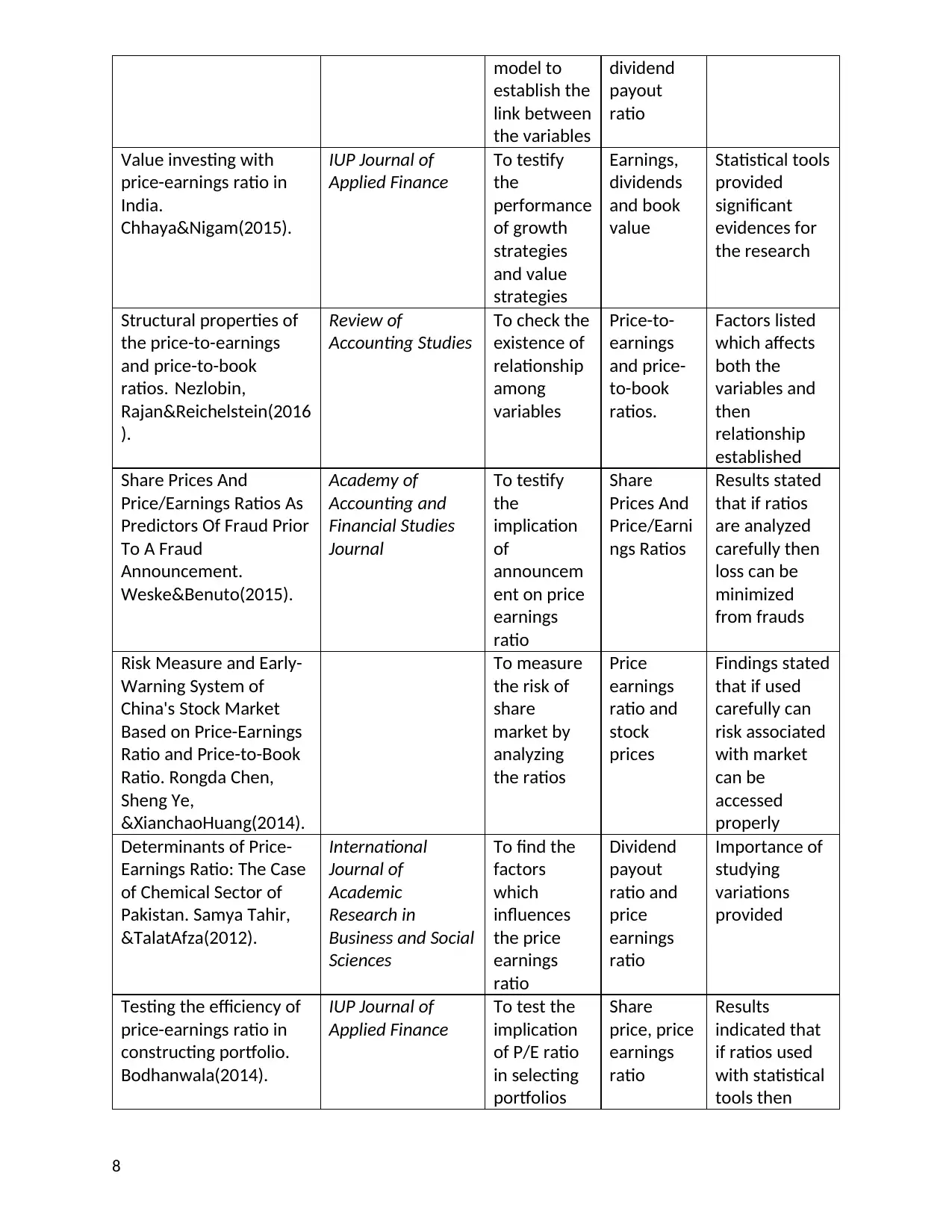
establish the
link between
the variables
dividend
payout
ratio
Value investing with
price-earnings ratio in
India.
Chhaya&Nigam(2015).
IUP Journal of
Applied Finance
To testify
the
performance
of growth
strategies
and value
strategies
Earnings,
dividends
and book
value
Statistical tools
provided
significant
evidences for
the research
Structural properties of
the price-to-earnings
and price-to-book
ratios. Nezlobin,
Rajan&Reichelstein(2016
).
Review of
Accounting Studies
To check the
existence of
relationship
among
variables
Price-to-
earnings
and price-
to-book
ratios.
Factors listed
which affects
both the
variables and
then
relationship
established
Share Prices And
Price/Earnings Ratios As
Predictors Of Fraud Prior
To A Fraud
Announcement.
Weske&Benuto(2015).
Academy of
Accounting and
Financial Studies
Journal
To testify
the
implication
of
announcem
ent on price
earnings
ratio
Share
Prices And
Price/Earni
ngs Ratios
Results stated
that if ratios
are analyzed
carefully then
loss can be
minimized
from frauds
Risk Measure and Early-
Warning System of
China's Stock Market
Based on Price-Earnings
Ratio and Price-to-Book
Ratio. Rongda Chen,
Sheng Ye,
&XianchaoHuang(2014).
To measure
the risk of
share
market by
analyzing
the ratios
Price
earnings
ratio and
stock
prices
Findings stated
that if used
carefully can
risk associated
with market
can be
accessed
properly
Determinants of Price-
Earnings Ratio: The Case
of Chemical Sector of
Pakistan. Samya Tahir,
&TalatAfza(2012).
International
Journal of
Academic
Research in
Business and Social
Sciences
To find the
factors
which
influences
the price
earnings
ratio
Dividend
payout
ratio and
price
earnings
ratio
Importance of
studying
variations
provided
Testing the efficiency of
price-earnings ratio in
constructing portfolio.
Bodhanwala(2014).
IUP Journal of
Applied Finance
To test the
implication
of P/E ratio
in selecting
portfolios
Share
price, price
earnings
ratio
Results
indicated that
if ratios used
with statistical
tools then
8

were found
Improved alternatives to
price multiple and
earnings growth ratios
used by bottom-up
investors. DeBoeuf, Lee
&Stanley(2013).
Applied Financial
Economics
To measure
the risk of
share
market by
analyzing
the ratios
earnings
growth
ratios
Do residual earnings
price ratios explain
cross-sectional variations
in stock returns?
Dudney, Jirasakuldech,
Zorn&Emekter(2015).
Managerial
Finance
To
determine
the
fundaments
which can
be
determined
and other
which
cannot be
determine
Price
earnings
ratio and
earnings
price ratio
What Is Your Eps? Issues
In Computing And
Interpreting Earnings Per
Share. Jewell
&Mankin(2016).
Academy of
Accounting and
Financial Studies
Journal
To
demonstrate
various ways
in which EPS
can be
calculated
Earnings
per share,
shareholde
rs fund and
number of
shareholde
rs
Problems in
determining
EPS
highlighted
and solutions
provided
The effect of earnings
per share categories on
share price behavior:
Some south African
evidence. Robbetze, de
Villiers &Harmse(2017).
Journal of Applied
Business Research
To link
earnings per
share with
price of
shares in
market
Earnings
per share
and stock
prices
Recommendati
ons provided
to guide both
managers and
investors
Empirical Analysis Of The
Impact Of
Comprehensive Income
On Basic Earnings Per
Share For Spanish
Companies Listed On
Madrid Stock
Exchange. Francisco
Sousa Fernández&María
Mercedes
CarroArana(2011).
International
Business &
Economics
Research Journal
To show the
difference in
calculation
by
comprehensi
ve and net
income
Earnings
per share,
gross and
net income
Comprehensiv
e method is
considered
more efficient
Speculative And Pure
Risks: Their Impact On
Firms' Earnings Per
Journal of
International
Business Research
To show the
impact of
beta values
Earnings
per share,
market
No significant
impact on EPS
found
9
⊘ This is a preview!⊘
Do you want full access?
Subscribe today to unlock all pages.

Trusted by 1+ million students worldwide

Mallari(2011).
on earnings
per share
share and
beta value
Impact of earnings per
share on market value of
an equity share: An
empirical study in indian
capital market. Bhatt, P.,
Dr, &Sumangala(2012).
Journal of Finance,
Accounting and
Management
To analyze
the changes
in MPS due
to variations
in EPS
Earnings
per share
and market
price of
share
Positive
relationship
found
The persistence of
earnings per share. Gil-
alana&Peláez(2008).
Review of
Quantitative
Finance and
Accounting
To check
how EPS is
persistence
in spite of
changes in
market
EPS and
equity
valuation
This reason is
linked with
business cycles
Improving earnings per
share: An illusory motive
in stock
repurchases. Wei
&Wang(2009).
International
Journal of Business
and Economics
To provide
information
regarding
effect of
repurchase
shares on
stock price
Earnings
per share,
marker
price of
share,
repurchase
plan
The country in
research was
not affected by
stock
repurchase
Earnings per Share:
Stylized Facts and New
Paradigms. Peláez(2007).
Journal Of
Behavioral
Finance,
To link the
variables of
EPS with
changes in
market
EPS, MPS Evidences
were not
consistent with
rationality in
market
"Determinants of equity
share prices in India."
Sharma & Sanjeet
(2011).
Researchers World
2, no. 4 (2011): 51
To examine
the
empirical
relationship
between
equity
Share prices
and
explanatory
variables
such as:
book value
per share,
dividend per
share and
others.
Book value
per share,
dividend
per share,
earning
per share,
price
earnings
ratio,
dividend
yield,
dividend
pay-out,
size in
terms of
sale and
net worth
for the
period
1993-94 to
The results
revealed that
earning per
share,
dividend per
share
and book value
per share has
significant
impact on
The market
price of share.
10
Paraphrase This Document
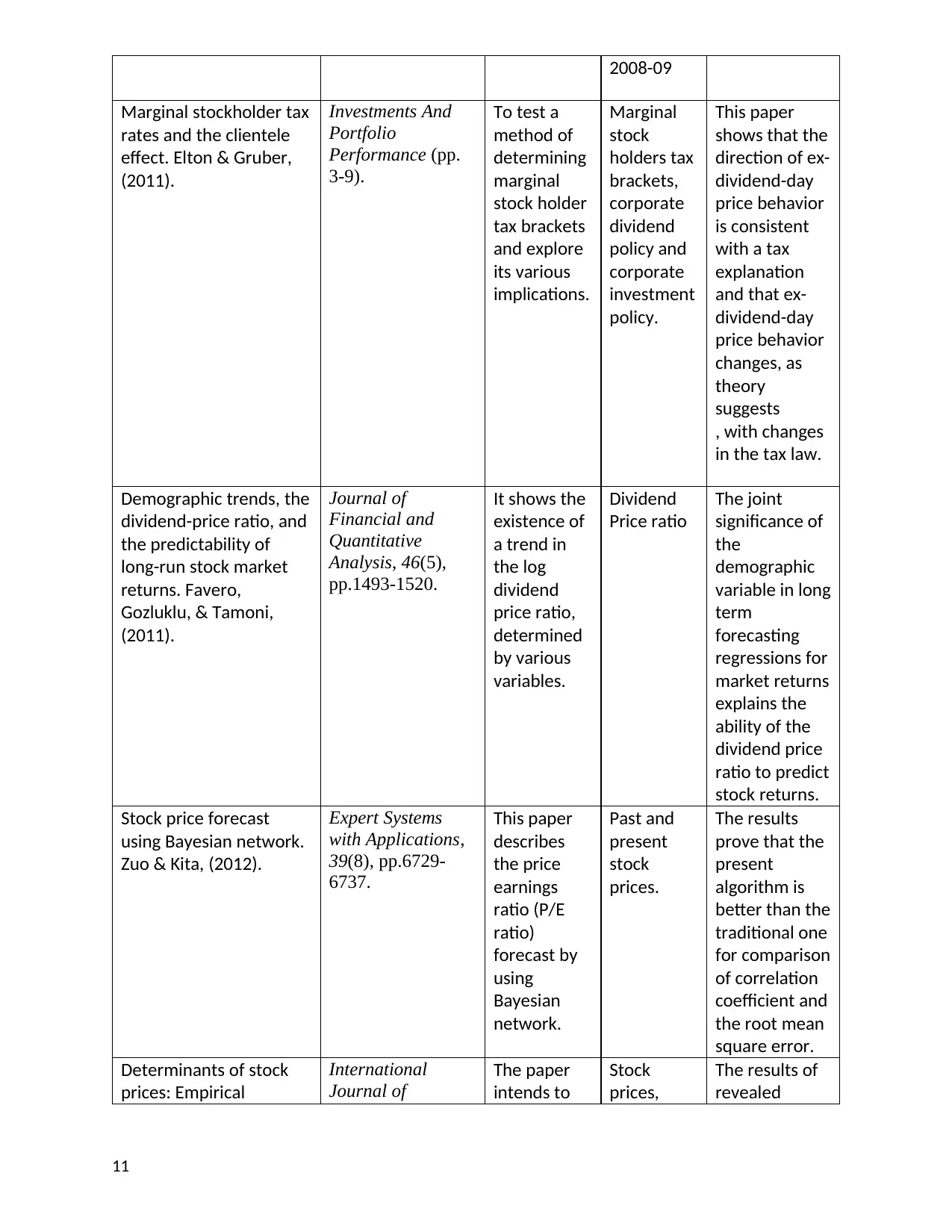
Marginal stockholder tax
rates and the clientele
effect. Elton & Gruber,
(2011).
Investments And
Portfolio
Performance (pp.
3-9).
To test a
method of
determining
marginal
stock holder
tax brackets
and explore
its various
implications.
Marginal
stock
holders tax
brackets,
corporate
dividend
policy and
corporate
investment
policy.
This paper
shows that the
direction of ex-
dividend-day
price behavior
is consistent
with a tax
explanation
and that ex-
dividend-day
price behavior
changes, as
theory
suggests
, with changes
in the tax law.
Demographic trends, the
dividend-price ratio, and
the predictability of
long-run stock market
returns. Favero,
Gozluklu, & Tamoni,
(2011).
Journal of
Financial and
Quantitative
Analysis, 46(5),
pp.1493-1520.
It shows the
existence of
a trend in
the log
dividend
price ratio,
determined
by various
variables.
Dividend
Price ratio
The joint
significance of
the
demographic
variable in long
term
forecasting
regressions for
market returns
explains the
ability of the
dividend price
ratio to predict
stock returns.
Stock price forecast
using Bayesian network.
Zuo & Kita, (2012).
Expert Systems
with Applications,
39(8), pp.6729-
6737.
This paper
describes
the price
earnings
ratio (P/E
ratio)
forecast by
using
Bayesian
network.
Past and
present
stock
prices.
The results
prove that the
present
algorithm is
better than the
traditional one
for comparison
of correlation
coefficient and
the root mean
square error.
Determinants of stock
prices: Empirical
International
Journal of
The paper
intends to
Stock
prices,
The results of
revealed
11
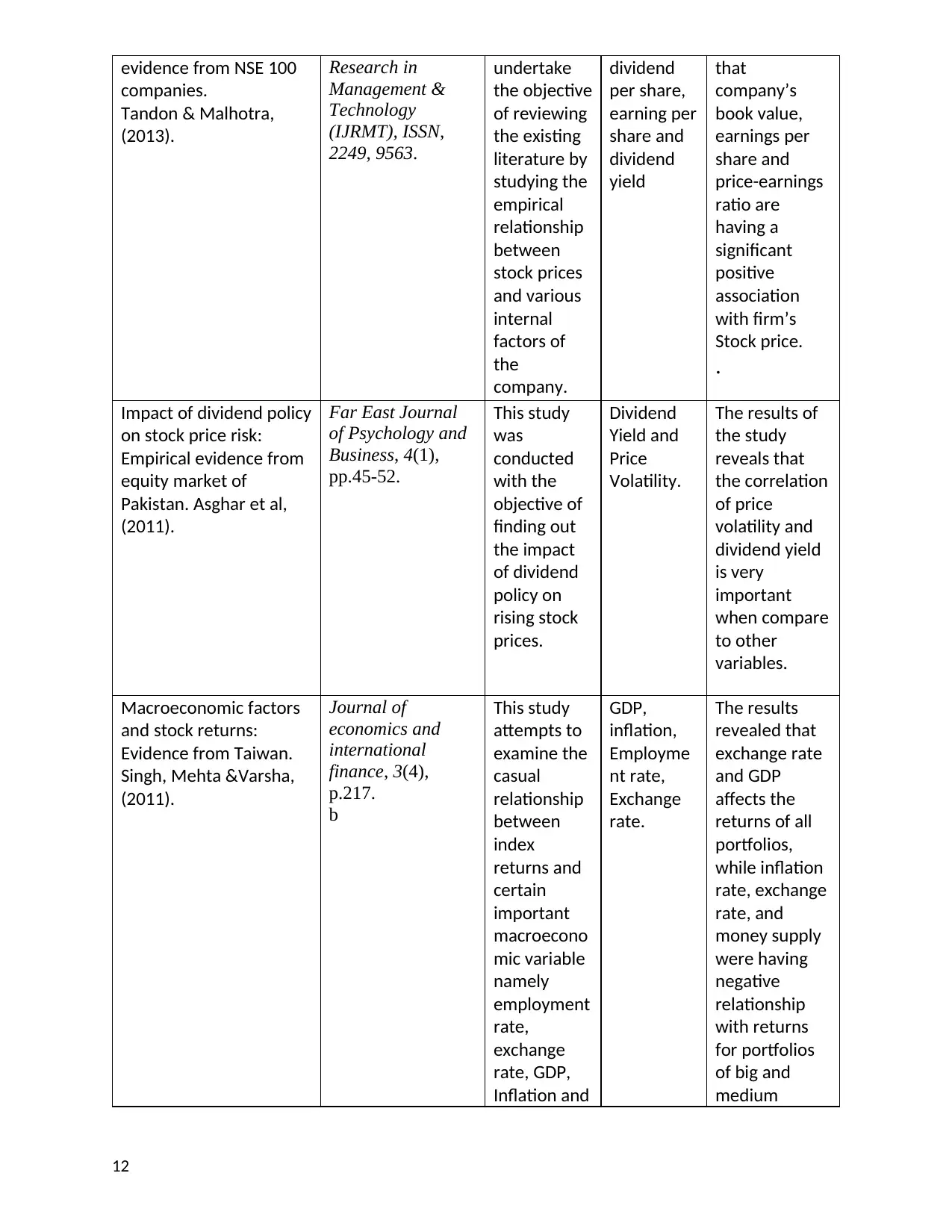
companies.
Tandon & Malhotra,
(2013).
Research in
Management &
Technology
(IJRMT), ISSN,
2249, 9563.
undertake
the objective
of reviewing
the existing
literature by
studying the
empirical
relationship
between
stock prices
and various
internal
factors of
the
company.
dividend
per share,
earning per
share and
dividend
yield
that
company’s
book value,
earnings per
share and
price-earnings
ratio are
having a
significant
positive
association
with firm’s
Stock price.
.
Impact of dividend policy
on stock price risk:
Empirical evidence from
equity market of
Pakistan. Asghar et al,
(2011).
Far East Journal
of Psychology and
Business, 4(1),
pp.45-52.
This study
was
conducted
with the
objective of
finding out
the impact
of dividend
policy on
rising stock
prices.
Dividend
Yield and
Price
Volatility.
The results of
the study
reveals that
the correlation
of price
volatility and
dividend yield
is very
important
when compare
to other
variables.
Macroeconomic factors
and stock returns:
Evidence from Taiwan.
Singh, Mehta &Varsha,
(2011).
Journal of
economics and
international
finance, 3(4),
p.217.
b
This study
attempts to
examine the
casual
relationship
between
index
returns and
certain
important
macroecono
mic variable
namely
employment
rate,
exchange
rate, GDP,
Inflation and
GDP,
inflation,
Employme
nt rate,
Exchange
rate.
The results
revealed that
exchange rate
and GDP
affects the
returns of all
portfolios,
while inflation
rate, exchange
rate, and
money supply
were having
negative
relationship
with returns
for portfolios
of big and
medium
12
⊘ This is a preview!⊘
Do you want full access?
Subscribe today to unlock all pages.

Trusted by 1+ million students worldwide
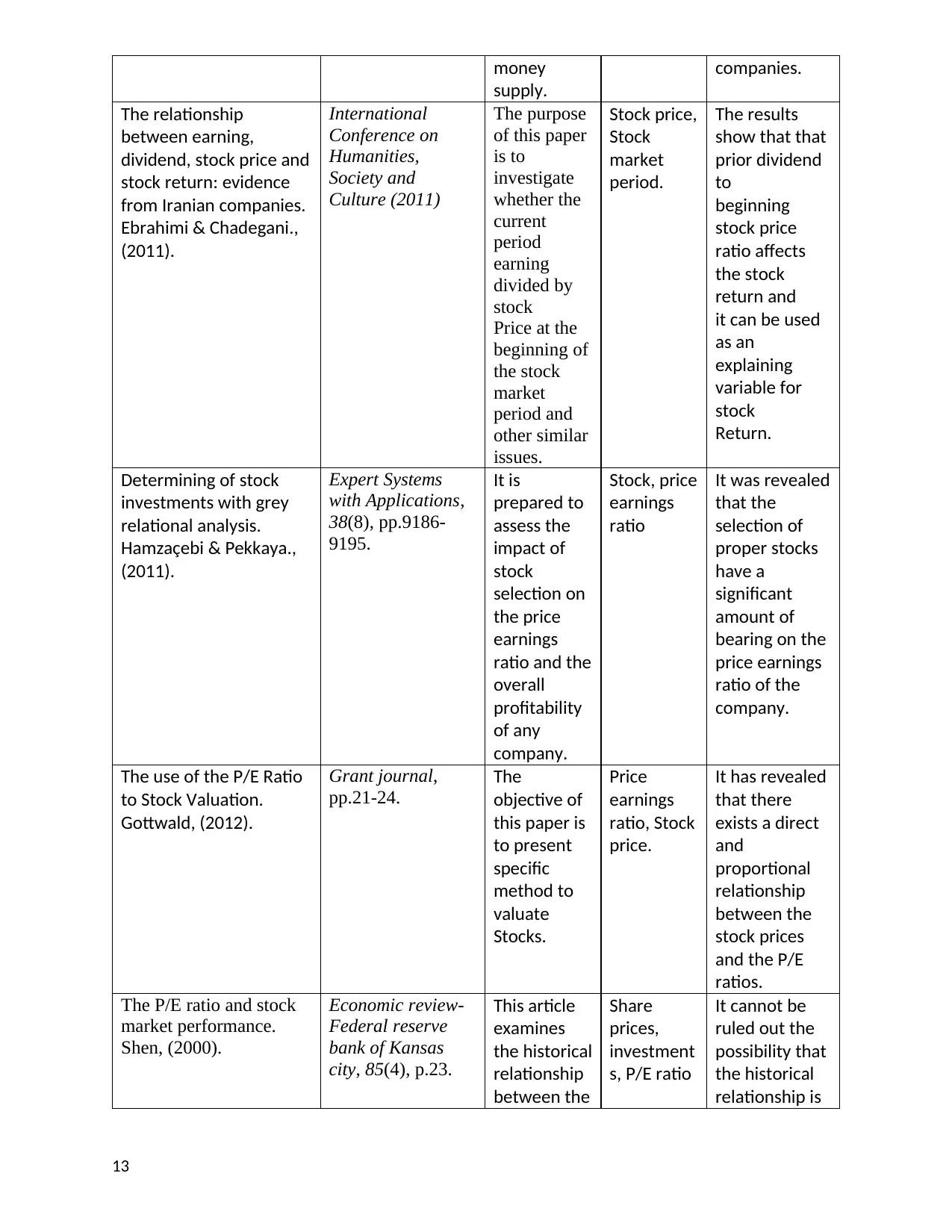
supply.
companies.
The relationship
between earning,
dividend, stock price and
stock return: evidence
from Iranian companies.
Ebrahimi & Chadegani.,
(2011).
International
Conference on
Humanities,
Society and
Culture (2011)
The purpose
of this paper
is to
investigate
whether the
current
period
earning
divided by
stock
Price at the
beginning of
the stock
market
period and
other similar
issues.
Stock price,
Stock
market
period.
The results
show that that
prior dividend
to
beginning
stock price
ratio affects
the stock
return and
it can be used
as an
explaining
variable for
stock
Return.
Determining of stock
investments with grey
relational analysis.
Hamzaçebi & Pekkaya.,
(2011).
Expert Systems
with Applications,
38(8), pp.9186-
9195.
It is
prepared to
assess the
impact of
stock
selection on
the price
earnings
ratio and the
overall
profitability
of any
company.
Stock, price
earnings
ratio
It was revealed
that the
selection of
proper stocks
have a
significant
amount of
bearing on the
price earnings
ratio of the
company.
The use of the P/E Ratio
to Stock Valuation.
Gottwald, (2012).
Grant journal,
pp.21-24.
The
objective of
this paper is
to present
specific
method to
valuate
Stocks.
Price
earnings
ratio, Stock
price.
It has revealed
that there
exists a direct
and
proportional
relationship
between the
stock prices
and the P/E
ratios.
The P/E ratio and stock
market performance.
Shen, (2000).
Economic review-
Federal reserve
bank of Kansas
city, 85(4), p.23.
This article
examines
the historical
relationship
between the
Share
prices,
investment
s, P/E ratio
It cannot be
ruled out the
possibility that
the historical
relationship is
13
Paraphrase This Document

earnings
ratios and
the
subsequent
stock market
performance
s.
of little
relevance
today due to
fundamental
changes in the
economy.
Jorgensen, Lee & Rock,
2014. The shapes of
scaled earnings
histograms are not due
to scaling and sample
selection: Evidence from
distributions of reported
earnings per share.
Contemporary
Accounting
Research, 31(2),
pp.498-521.
The main
objective of
the study is
to conduct
significant
research on
the earnings
per share,
which is
needed by
the
stakeholders
of any
company.
EPS. The study
reveals that
EPS is one of
the most
significant
factors in
determining
the overall
financial
health of any
company.
The anova to mixed
model transition.
Boisgontier & Cheval,
(2016).
Neuroscience &
Biobehavioral
Reviews, 68,
pp.1004-1005.
Here a
transition
towards a
mixed model
is shown as
the
requirement
s for using
analyses of
variances
are often
not met and
mixed
models
provide a
better
framework.
Linear
mixed
models.
It has been
discovered
that a
transition
towards LMM
is underway
and
neuroscientists
are lagging
behind
Compared to
other
scientists,
which must be
solved.
Stock prices and
inflation.
Anari, & Kolari, (2001)
Journal of
Financial
Research, 24(4),
pp.587-602.
The study
has been
done in
order to
report a
positive,
long run‐
Stock
Prices
It reveals that
stock prices
have a long
association with
inflation shocks,
such that
investors should
expect stocks to
14
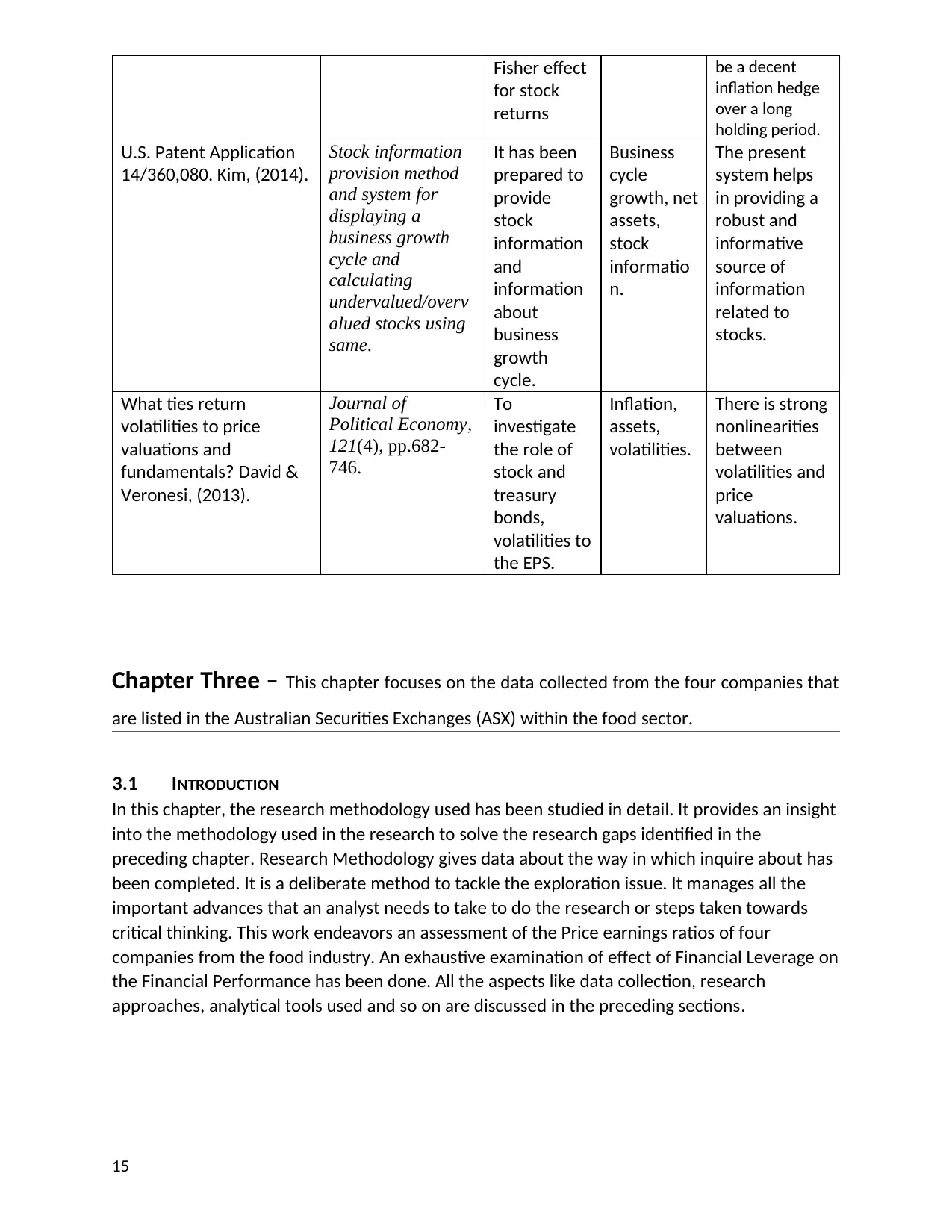
for stock
returns
be a decent
inflation hedge
over a long
holding period.
U.S. Patent Application
14/360,080. Kim, (2014).
Stock information
provision method
and system for
displaying a
business growth
cycle and
calculating
undervalued/overv
alued stocks using
same.
It has been
prepared to
provide
stock
information
and
information
about
business
growth
cycle.
Business
cycle
growth, net
assets,
stock
informatio
n.
The present
system helps
in providing a
robust and
informative
source of
information
related to
stocks.
What ties return
volatilities to price
valuations and
fundamentals? David &
Veronesi, (2013).
Journal of
Political Economy,
121(4), pp.682-
746.
To
investigate
the role of
stock and
treasury
bonds,
volatilities to
the EPS.
Inflation,
assets,
volatilities.
There is strong
nonlinearities
between
volatilities and
price
valuations.
Chapter Three – This chapter focuses on the data collected from the four companies that
are listed in the Australian Securities Exchanges (ASX) within the food sector.
3.1 INTRODUCTION
In this chapter, the research methodology used has been studied in detail. It provides an insight
into the methodology used in the research to solve the research gaps identified in the
preceding chapter. Research Methodology gives data about the way in which inquire about has
been completed. It is a deliberate method to tackle the exploration issue. It manages all the
important advances that an analyst needs to take to do the research or steps taken towards
critical thinking. This work endeavors an assessment of the Price earnings ratios of four
companies from the food industry. An exhaustive examination of effect of Financial Leverage on
the Financial Performance has been done. All the aspects like data collection, research
approaches, analytical tools used and so on are discussed in the preceding sections.
15
⊘ This is a preview!⊘
Do you want full access?
Subscribe today to unlock all pages.

Trusted by 1+ million students worldwide
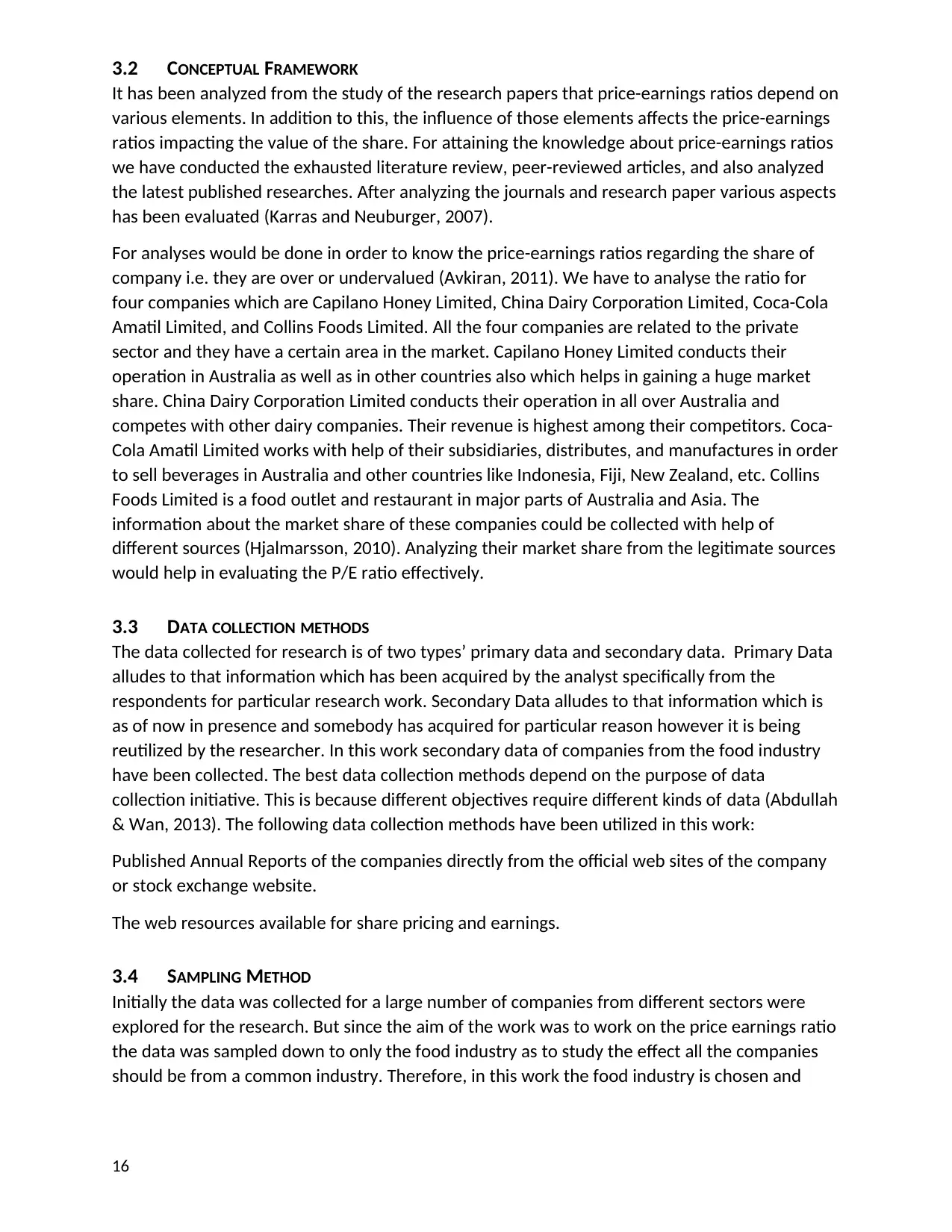
It has been analyzed from the study of the research papers that price-earnings ratios depend on
various elements. In addition to this, the influence of those elements affects the price-earnings
ratios impacting the value of the share. For attaining the knowledge about price-earnings ratios
we have conducted the exhausted literature review, peer-reviewed articles, and also analyzed
the latest published researches. After analyzing the journals and research paper various aspects
has been evaluated (Karras and Neuburger, 2007).
For analyses would be done in order to know the price-earnings ratios regarding the share of
company i.e. they are over or undervalued (Avkiran, 2011). We have to analyse the ratio for
four companies which are Capilano Honey Limited, China Dairy Corporation Limited, Coca-Cola
Amatil Limited, and Collins Foods Limited. All the four companies are related to the private
sector and they have a certain area in the market. Capilano Honey Limited conducts their
operation in Australia as well as in other countries also which helps in gaining a huge market
share. China Dairy Corporation Limited conducts their operation in all over Australia and
competes with other dairy companies. Their revenue is highest among their competitors. Coca-
Cola Amatil Limited works with help of their subsidiaries, distributes, and manufactures in order
to sell beverages in Australia and other countries like Indonesia, Fiji, New Zealand, etc. Collins
Foods Limited is a food outlet and restaurant in major parts of Australia and Asia. The
information about the market share of these companies could be collected with help of
different sources (Hjalmarsson, 2010). Analyzing their market share from the legitimate sources
would help in evaluating the P/E ratio effectively.
3.3 DATA COLLECTION METHODS
The data collected for research is of two types’ primary data and secondary data. Primary Data
alludes to that information which has been acquired by the analyst specifically from the
respondents for particular research work. Secondary Data alludes to that information which is
as of now in presence and somebody has acquired for particular reason however it is being
reutilized by the researcher. In this work secondary data of companies from the food industry
have been collected. The best data collection methods depend on the purpose of data
collection initiative. This is because different objectives require different kinds of data (Abdullah
& Wan, 2013). The following data collection methods have been utilized in this work:
Published Annual Reports of the companies directly from the official web sites of the company
or stock exchange website.
The web resources available for share pricing and earnings.
3.4 SAMPLING METHOD
Initially the data was collected for a large number of companies from different sectors were
explored for the research. But since the aim of the work was to work on the price earnings ratio
the data was sampled down to only the food industry as to study the effect all the companies
should be from a common industry. Therefore, in this work the food industry is chosen and
16
Paraphrase This Document
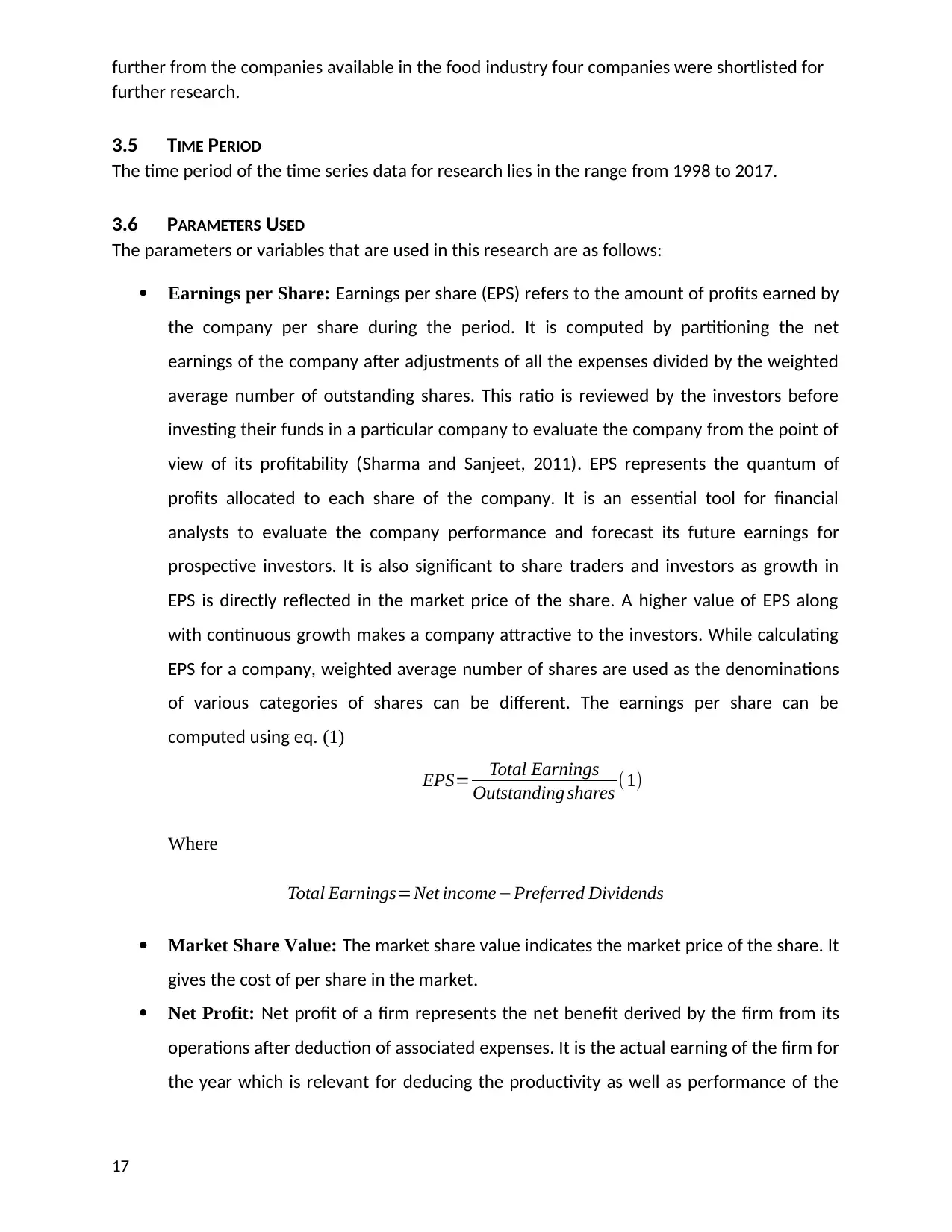
further research.
3.5 TIME PERIOD
The time period of the time series data for research lies in the range from 1998 to 2017.
3.6 PARAMETERS USED
The parameters or variables that are used in this research are as follows:
Earnings per Share: Earnings per share (EPS) refers to the amount of profits earned by
the company per share during the period. It is computed by partitioning the net
earnings of the company after adjustments of all the expenses divided by the weighted
average number of outstanding shares. This ratio is reviewed by the investors before
investing their funds in a particular company to evaluate the company from the point of
view of its profitability (Sharma and Sanjeet, 2011). EPS represents the quantum of
profits allocated to each share of the company. It is an essential tool for financial
analysts to evaluate the company performance and forecast its future earnings for
prospective investors. It is also significant to share traders and investors as growth in
EPS is directly reflected in the market price of the share. A higher value of EPS along
with continuous growth makes a company attractive to the investors. While calculating
EPS for a company, weighted average number of shares are used as the denominations
of various categories of shares can be different. The earnings per share can be
computed using eq. (1)
EPS= Total Earnings
Outstanding shares ( 1)
Where
Total Earnings=Net income−Preferred Dividends
Market Share Value: The market share value indicates the market price of the share. It
gives the cost of per share in the market.
Net Profit: Net profit of a firm represents the net benefit derived by the firm from its
operations after deduction of associated expenses. It is the actual earning of the firm for
the year which is relevant for deducing the productivity as well as performance of the
17
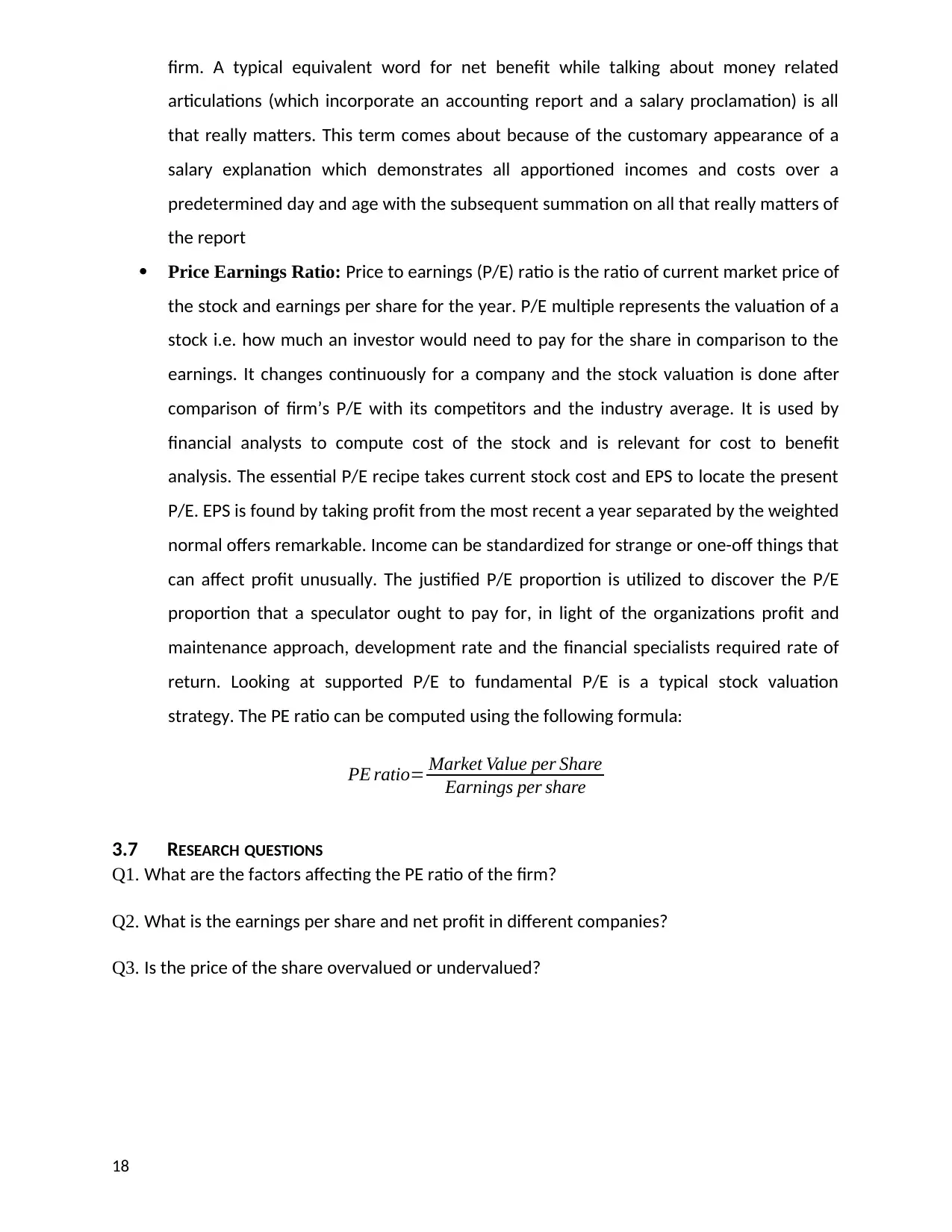
articulations (which incorporate an accounting report and a salary proclamation) is all
that really matters. This term comes about because of the customary appearance of a
salary explanation which demonstrates all apportioned incomes and costs over a
predetermined day and age with the subsequent summation on all that really matters of
the report
Price Earnings Ratio: Price to earnings (P/E) ratio is the ratio of current market price of
the stock and earnings per share for the year. P/E multiple represents the valuation of a
stock i.e. how much an investor would need to pay for the share in comparison to the
earnings. It changes continuously for a company and the stock valuation is done after
comparison of firm’s P/E with its competitors and the industry average. It is used by
financial analysts to compute cost of the stock and is relevant for cost to benefit
analysis. The essential P/E recipe takes current stock cost and EPS to locate the present
P/E. EPS is found by taking profit from the most recent a year separated by the weighted
normal offers remarkable. Income can be standardized for strange or one-off things that
can affect profit unusually. The justified P/E proportion is utilized to discover the P/E
proportion that a speculator ought to pay for, in light of the organizations profit and
maintenance approach, development rate and the financial specialists required rate of
return. Looking at supported P/E to fundamental P/E is a typical stock valuation
strategy. The PE ratio can be computed using the following formula:
PE ratio= Market Value per Share
Earnings per share
3.7 RESEARCH QUESTIONS
Q1. What are the factors affecting the PE ratio of the firm?
Q2. What is the earnings per share and net profit in different companies?
Q3. Is the price of the share overvalued or undervalued?
18
⊘ This is a preview!⊘
Do you want full access?
Subscribe today to unlock all pages.

Trusted by 1+ million students worldwide
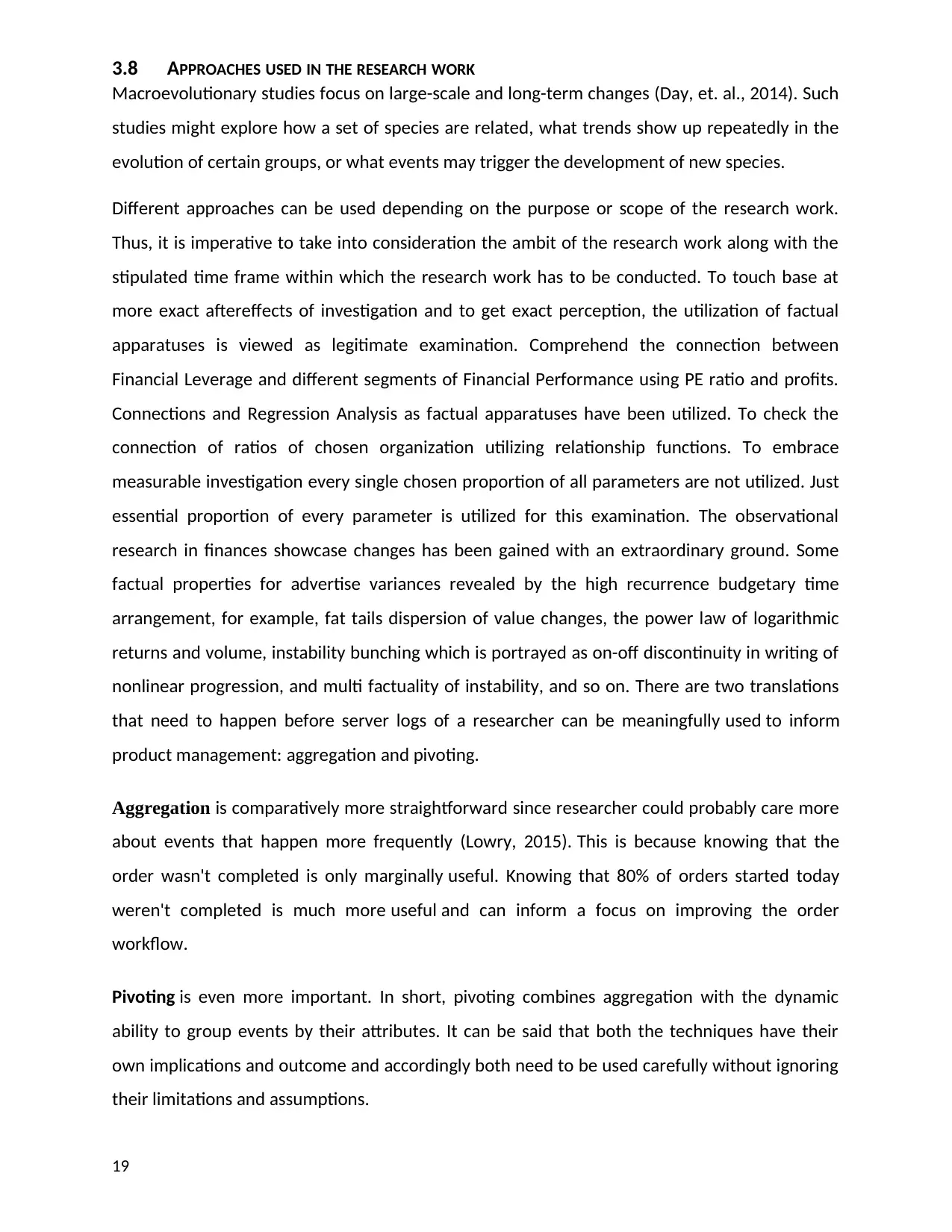
Macroevolutionary studies focus on large-scale and long-term changes (Day, et. al., 2014). Such
studies might explore how a set of species are related, what trends show up repeatedly in the
evolution of certain groups, or what events may trigger the development of new species.
Different approaches can be used depending on the purpose or scope of the research work.
Thus, it is imperative to take into consideration the ambit of the research work along with the
stipulated time frame within which the research work has to be conducted. To touch base at
more exact aftereffects of investigation and to get exact perception, the utilization of factual
apparatuses is viewed as legitimate examination. Comprehend the connection between
Financial Leverage and different segments of Financial Performance using PE ratio and profits.
Connections and Regression Analysis as factual apparatuses have been utilized. To check the
connection of ratios of chosen organization utilizing relationship functions. To embrace
measurable investigation every single chosen proportion of all parameters are not utilized. Just
essential proportion of every parameter is utilized for this examination. The observational
research in finances showcase changes has been gained with an extraordinary ground. Some
factual properties for advertise variances revealed by the high recurrence budgetary time
arrangement, for example, fat tails dispersion of value changes, the power law of logarithmic
returns and volume, instability bunching which is portrayed as on-off discontinuity in writing of
nonlinear progression, and multi factuality of instability, and so on. There are two translations
that need to happen before server logs of a researcher can be meaningfully used to inform
product management: aggregation and pivoting.
Aggregation is comparatively more straightforward since researcher could probably care more
about events that happen more frequently (Lowry, 2015). This is because knowing that the
order wasn't completed is only marginally useful. Knowing that 80% of orders started today
weren't completed is much more useful and can inform a focus on improving the order
workflow.
Pivoting is even more important. In short, pivoting combines aggregation with the dynamic
ability to group events by their attributes. It can be said that both the techniques have their
own implications and outcome and accordingly both need to be used carefully without ignoring
their limitations and assumptions.
19
Paraphrase This Document
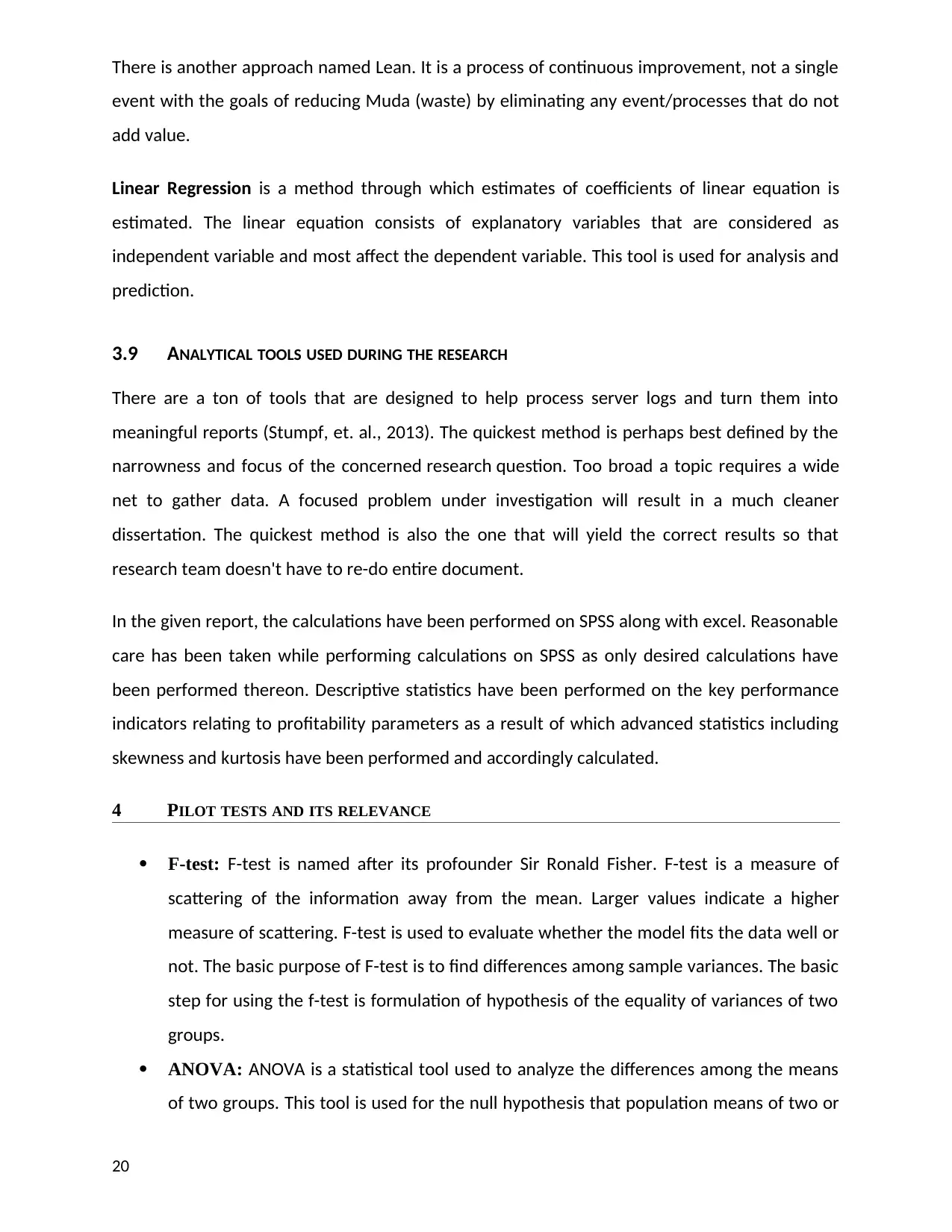
event with the goals of reducing Muda (waste) by eliminating any event/processes that do not
add value.
Linear Regression is a method through which estimates of coefficients of linear equation is
estimated. The linear equation consists of explanatory variables that are considered as
independent variable and most affect the dependent variable. This tool is used for analysis and
prediction.
3.9 ANALYTICAL TOOLS USED DURING THE RESEARCH
There are a ton of tools that are designed to help process server logs and turn them into
meaningful reports (Stumpf, et. al., 2013). The quickest method is perhaps best defined by the
narrowness and focus of the concerned research question. Too broad a topic requires a wide
net to gather data. A focused problem under investigation will result in a much cleaner
dissertation. The quickest method is also the one that will yield the correct results so that
research team doesn't have to re-do entire document.
In the given report, the calculations have been performed on SPSS along with excel. Reasonable
care has been taken while performing calculations on SPSS as only desired calculations have
been performed thereon. Descriptive statistics have been performed on the key performance
indicators relating to profitability parameters as a result of which advanced statistics including
skewness and kurtosis have been performed and accordingly calculated.
4 PILOT TESTS AND ITS RELEVANCE
F-test: F-test is named after its profounder Sir Ronald Fisher. F-test is a measure of
scattering of the information away from the mean. Larger values indicate a higher
measure of scattering. F-test is used to evaluate whether the model fits the data well or
not. The basic purpose of F-test is to find differences among sample variances. The basic
step for using the f-test is formulation of hypothesis of the equality of variances of two
groups.
ANOVA: ANOVA is a statistical tool used to analyze the differences among the means
of two groups. This tool is used for the null hypothesis that population means of two or
20
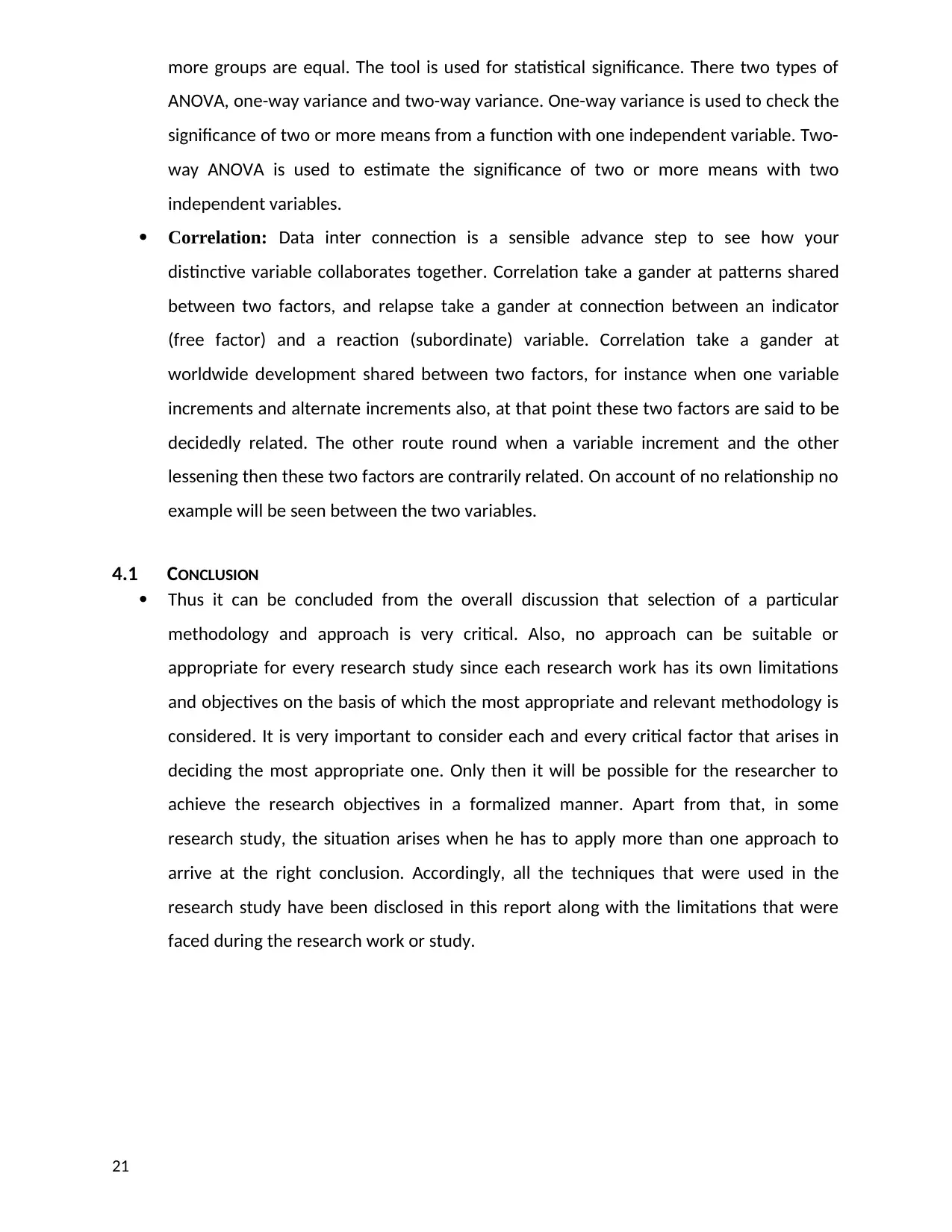
ANOVA, one-way variance and two-way variance. One-way variance is used to check the
significance of two or more means from a function with one independent variable. Two-
way ANOVA is used to estimate the significance of two or more means with two
independent variables.
Correlation: Data inter connection is a sensible advance step to see how your
distinctive variable collaborates together. Correlation take a gander at patterns shared
between two factors, and relapse take a gander at connection between an indicator
(free factor) and a reaction (subordinate) variable. Correlation take a gander at
worldwide development shared between two factors, for instance when one variable
increments and alternate increments also, at that point these two factors are said to be
decidedly related. The other route round when a variable increment and the other
lessening then these two factors are contrarily related. On account of no relationship no
example will be seen between the two variables.
4.1 CONCLUSION
Thus it can be concluded from the overall discussion that selection of a particular
methodology and approach is very critical. Also, no approach can be suitable or
appropriate for every research study since each research work has its own limitations
and objectives on the basis of which the most appropriate and relevant methodology is
considered. It is very important to consider each and every critical factor that arises in
deciding the most appropriate one. Only then it will be possible for the researcher to
achieve the research objectives in a formalized manner. Apart from that, in some
research study, the situation arises when he has to apply more than one approach to
arrive at the right conclusion. Accordingly, all the techniques that were used in the
research study have been disclosed in this report along with the limitations that were
faced during the research work or study.
21
⊘ This is a preview!⊘
Do you want full access?
Subscribe today to unlock all pages.

Trusted by 1+ million students worldwide
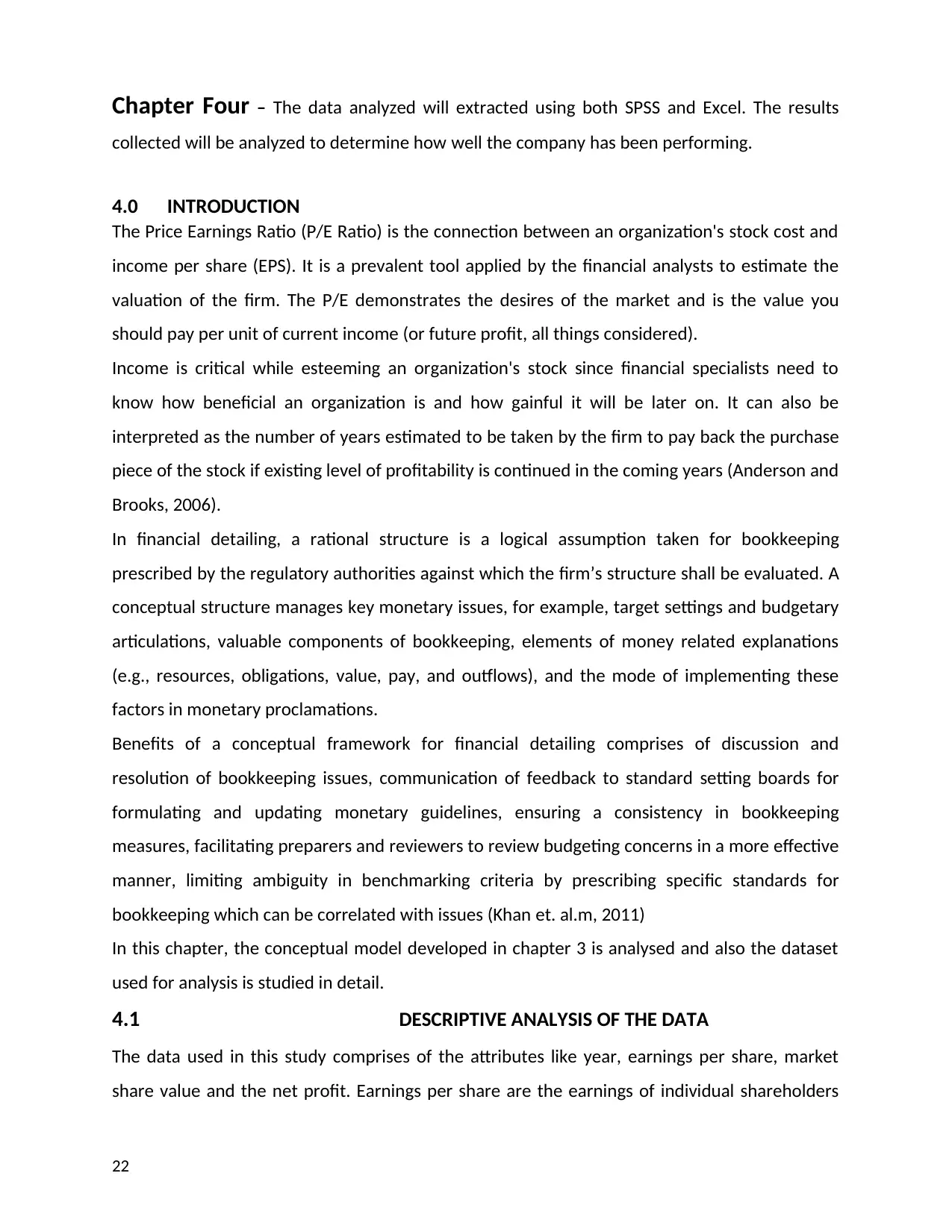
collected will be analyzed to determine how well the company has been performing.
4.0 INTRODUCTION
The Price Earnings Ratio (P/E Ratio) is the connection between an organization's stock cost and
income per share (EPS). It is a prevalent tool applied by the financial analysts to estimate the
valuation of the firm. The P/E demonstrates the desires of the market and is the value you
should pay per unit of current income (or future profit, all things considered).
Income is critical while esteeming an organization's stock since financial specialists need to
know how beneficial an organization is and how gainful it will be later on. It can also be
interpreted as the number of years estimated to be taken by the firm to pay back the purchase
piece of the stock if existing level of profitability is continued in the coming years (Anderson and
Brooks, 2006).
In financial detailing, a rational structure is a logical assumption taken for bookkeeping
prescribed by the regulatory authorities against which the firm’s structure shall be evaluated. A
conceptual structure manages key monetary issues, for example, target settings and budgetary
articulations, valuable components of bookkeeping, elements of money related explanations
(e.g., resources, obligations, value, pay, and outflows), and the mode of implementing these
factors in monetary proclamations.
Benefits of a conceptual framework for financial detailing comprises of discussion and
resolution of bookkeeping issues, communication of feedback to standard setting boards for
formulating and updating monetary guidelines, ensuring a consistency in bookkeeping
measures, facilitating preparers and reviewers to review budgeting concerns in a more effective
manner, limiting ambiguity in benchmarking criteria by prescribing specific standards for
bookkeeping which can be correlated with issues (Khan et. al.m, 2011)
In this chapter, the conceptual model developed in chapter 3 is analysed and also the dataset
used for analysis is studied in detail.
4.1 DESCRIPTIVE ANALYSIS OF THE DATA
The data used in this study comprises of the attributes like year, earnings per share, market
share value and the net profit. Earnings per share are the earnings of individual shareholders
22
Paraphrase This Document

basic and diluted. Basic earnings per share do not consider the impact of future obligations such
as conversion of preference shares and shares buying option. It is simply calculated by dividing
earnings with number of shareholders. On the other hand, diluted earnings consider the future
impact of the equities and debt on number of shares. Thus, it can be said that diluted earnings
per share is less risky than basic earnings per share. The other factor that will be used is market
price of share. Market price of share is the price at which shareholders are ready to buy the
shares. It is influenced by various factors such as profitability, earnings per share and market
share of organization etc. The price listed in stock exchange will be used as market price of
share.
S.No. Attribute Significance
1. Year Time series value
2. Earnings per Share Earnings of an individual from these shares
3. Market share Value The market price of the share
4. Net profit The final profit earned from the share
Table 1: Data Used for analysis
The dataset was tested on four different companies from foods and beverage sector these
include:
CAPILANO HONEY LIMITED
CHINA DAIRY CORPORATION LIMITED
COCA-COLA AMATIL LIMITED
COLLINS FOODS LIMITED
The data set contains historical time series data from the year 1998 to the year 2016. Thus, this
time series data helps us in finding the patterns of earning for all the four companies. The
descriptive analysis of the data is given in table 2. The number of samples used is sixty-six for
analysis of the data the descriptive analysis of the data was performed on the SPSS tool and the
various parameters like mean, standard deviation, variance, scenes etc. were computed. The
descriptive analysis is given in table 2.
Variable Range Mi
n
Max Sum Mean Std.
Deviatio
Variance Skewn Kurto
23
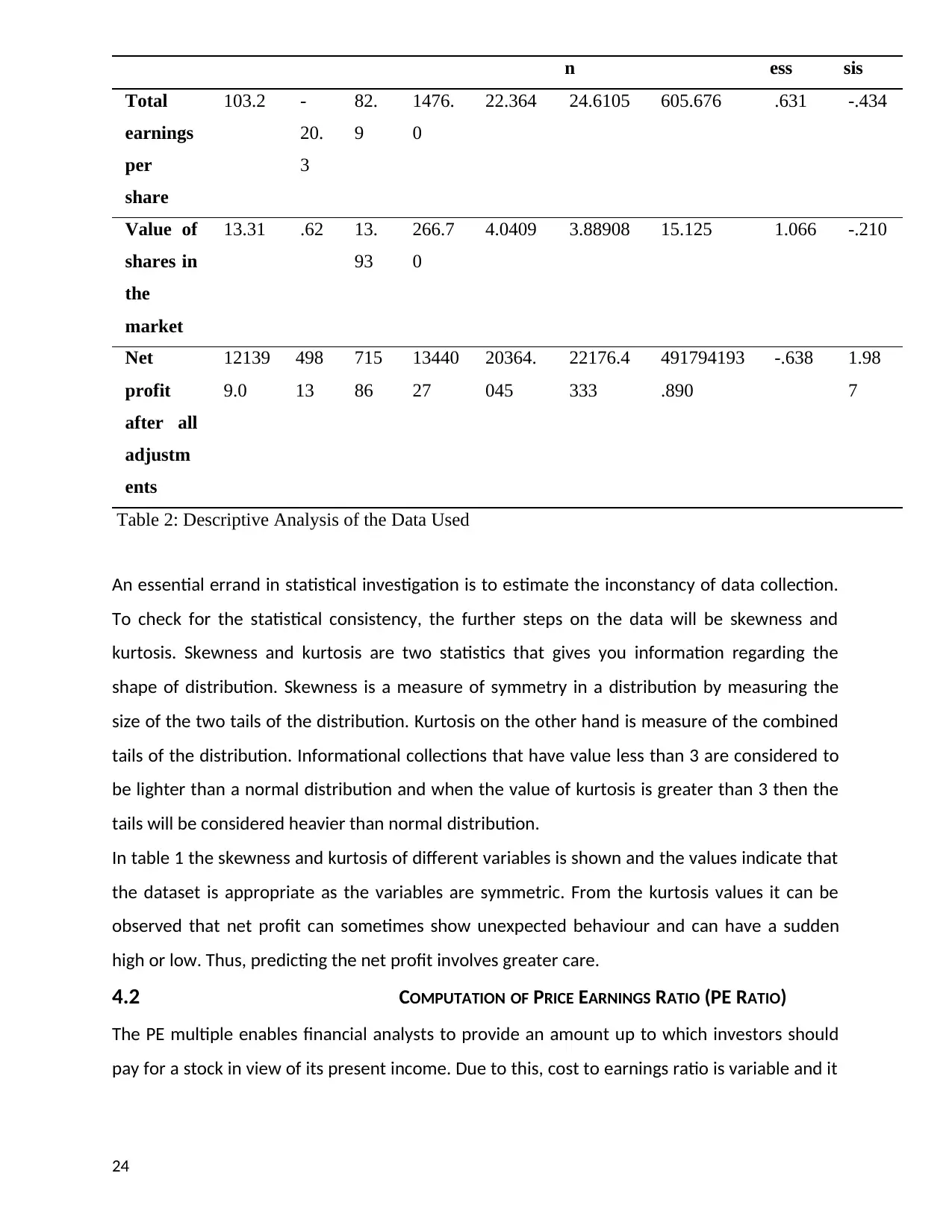
Total
earnings
per
share
103.2 -
20.
3
82.
9
1476.
0
22.364 24.6105 605.676 .631 -.434
Value of
shares in
the
market
13.31 .62 13.
93
266.7
0
4.0409 3.88908 15.125 1.066 -.210
Net
profit
after all
adjustm
ents
12139
9.0
498
13
715
86
13440
27
20364.
045
22176.4
333
491794193
.890
-.638 1.98
7
Table 2: Descriptive Analysis of the Data Used
An essential errand in statistical investigation is to estimate the inconstancy of data collection.
To check for the statistical consistency, the further steps on the data will be skewness and
kurtosis. Skewness and kurtosis are two statistics that gives you information regarding the
shape of distribution. Skewness is a measure of symmetry in a distribution by measuring the
size of the two tails of the distribution. Kurtosis on the other hand is measure of the combined
tails of the distribution. Informational collections that have value less than 3 are considered to
be lighter than a normal distribution and when the value of kurtosis is greater than 3 then the
tails will be considered heavier than normal distribution.
In table 1 the skewness and kurtosis of different variables is shown and the values indicate that
the dataset is appropriate as the variables are symmetric. From the kurtosis values it can be
observed that net profit can sometimes show unexpected behaviour and can have a sudden
high or low. Thus, predicting the net profit involves greater care.
4.2 COMPUTATION OF PRICE EARNINGS RATIO (PE RATIO)
The PE multiple enables financial analysts to provide an amount up to which investors should
pay for a stock in view of its present income. Due to this, cost to earnings ratio is variable and it
24
⊘ This is a preview!⊘
Do you want full access?
Subscribe today to unlock all pages.

Trusted by 1+ million students worldwide
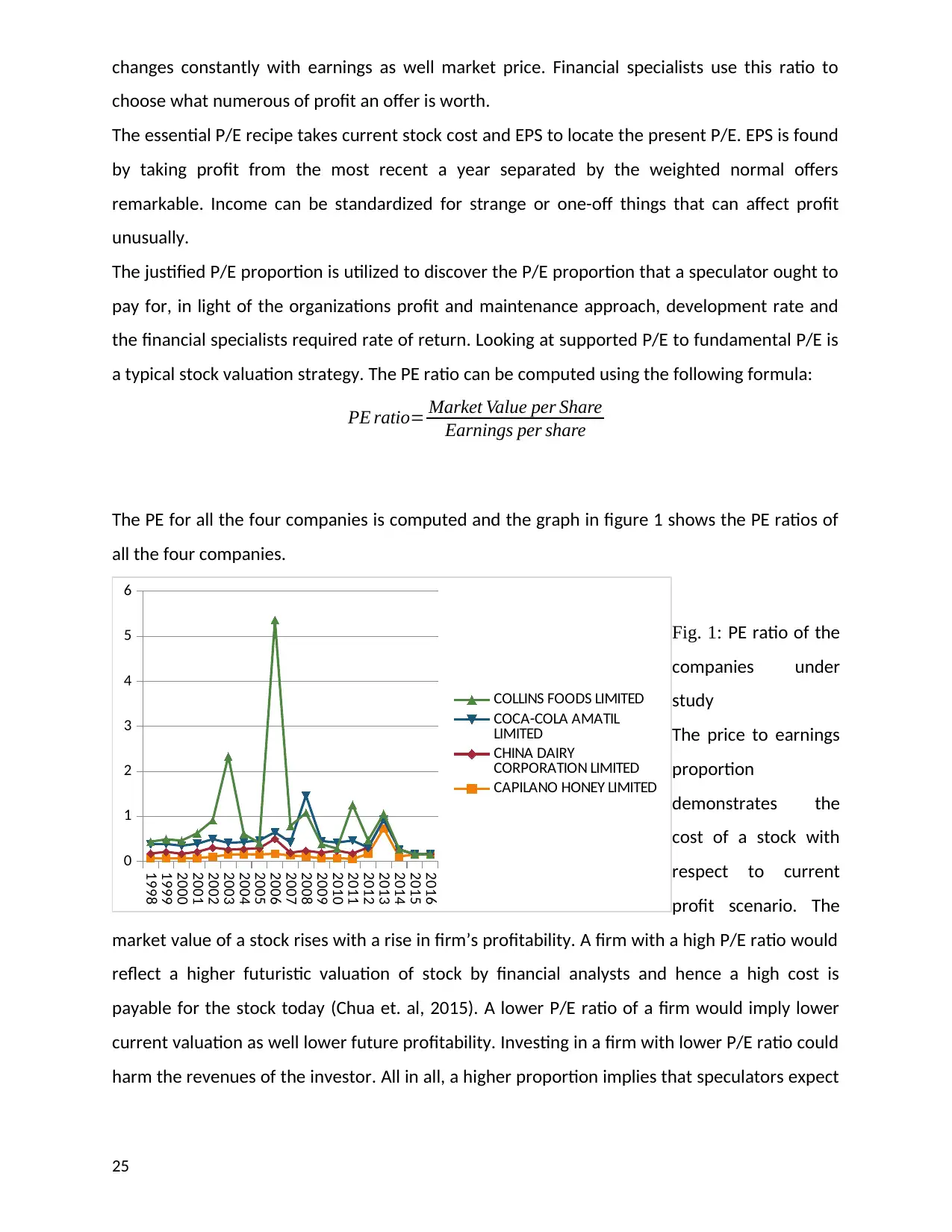
choose what numerous of profit an offer is worth.
The essential P/E recipe takes current stock cost and EPS to locate the present P/E. EPS is found
by taking profit from the most recent a year separated by the weighted normal offers
remarkable. Income can be standardized for strange or one-off things that can affect profit
unusually.
The justified P/E proportion is utilized to discover the P/E proportion that a speculator ought to
pay for, in light of the organizations profit and maintenance approach, development rate and
the financial specialists required rate of return. Looking at supported P/E to fundamental P/E is
a typical stock valuation strategy. The PE ratio can be computed using the following formula:
PE ratio= Market Value per Share
Earnings per share
The PE for all the four companies is computed and the graph in figure 1 shows the PE ratios of
all the four companies.
Fig. 1: PE ratio of the
companies under
study
The price to earnings
proportion
demonstrates the
cost of a stock with
respect to current
profit scenario. The
market value of a stock rises with a rise in firm’s profitability. A firm with a high P/E ratio would
reflect a higher futuristic valuation of stock by financial analysts and hence a high cost is
payable for the stock today (Chua et. al, 2015). A lower P/E ratio of a firm would imply lower
current valuation as well lower future profitability. Investing in a firm with lower P/E ratio could
harm the revenues of the investor. All in all, a higher proportion implies that speculators expect
25
1998
1999
2000
2001
2002
2003
2004
2005
2006
2007
2008
2009
2010
2011
2012
2013
2014
2015
2016
0
1
2
3
4
5
6
COLLINS FOODS LIMITED
COCA-COLA AMATIL
LIMITED
CHINA DAIRY
CORPORATION LIMITED
CAPILANO HONEY LIMITED
Paraphrase This Document
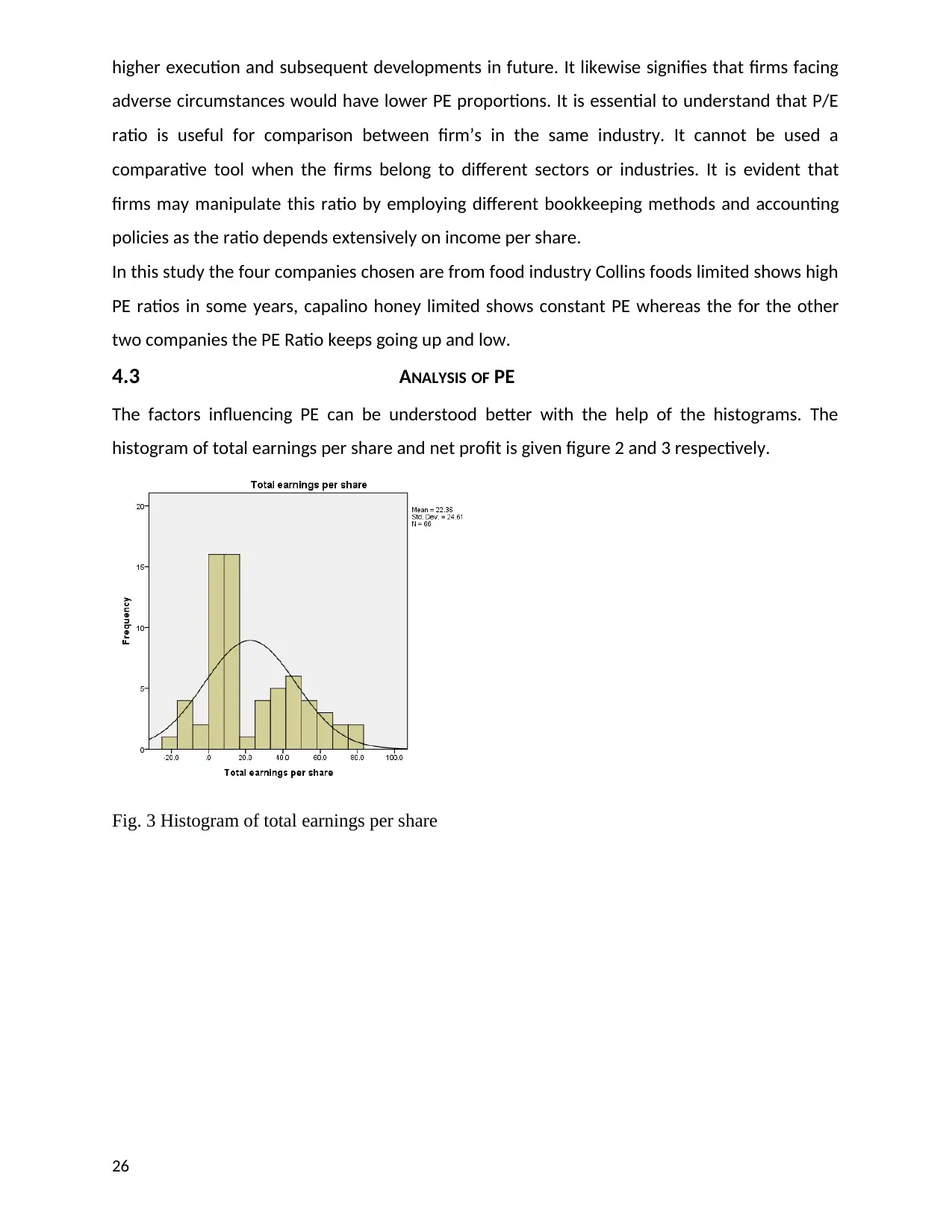
adverse circumstances would have lower PE proportions. It is essential to understand that P/E
ratio is useful for comparison between firm’s in the same industry. It cannot be used a
comparative tool when the firms belong to different sectors or industries. It is evident that
firms may manipulate this ratio by employing different bookkeeping methods and accounting
policies as the ratio depends extensively on income per share.
In this study the four companies chosen are from food industry Collins foods limited shows high
PE ratios in some years, capalino honey limited shows constant PE whereas the for the other
two companies the PE Ratio keeps going up and low.
4.3 ANALYSIS OF PE
The factors influencing PE can be understood better with the help of the histograms. The
histogram of total earnings per share and net profit is given figure 2 and 3 respectively.
Fig. 3 Histogram of total earnings per share
26
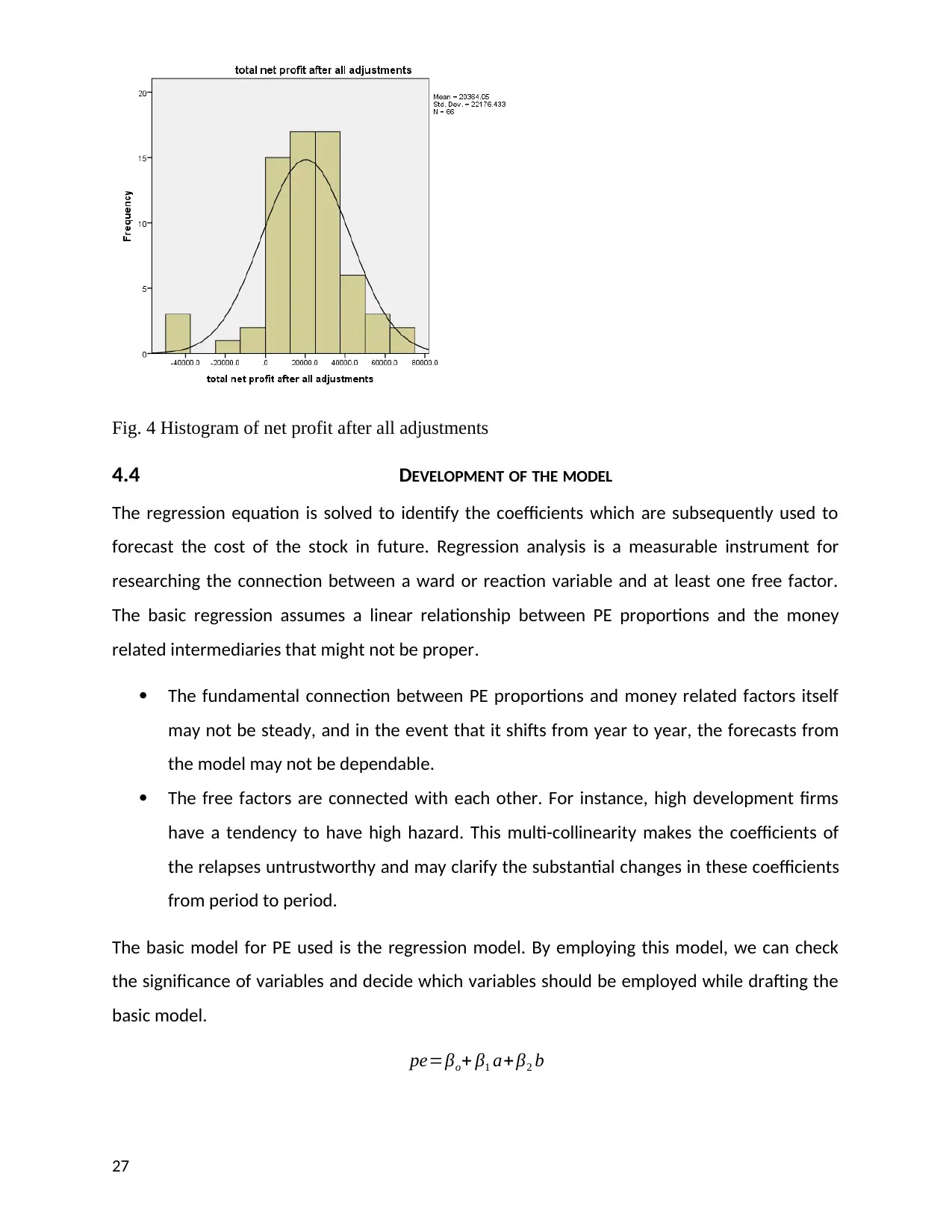
4.4 DEVELOPMENT OF THE MODEL
The regression equation is solved to identify the coefficients which are subsequently used to
forecast the cost of the stock in future. Regression analysis is a measurable instrument for
researching the connection between a ward or reaction variable and at least one free factor.
The basic regression assumes a linear relationship between PE proportions and the money
related intermediaries that might not be proper.
The fundamental connection between PE proportions and money related factors itself
may not be steady, and in the event that it shifts from year to year, the forecasts from
the model may not be dependable.
The free factors are connected with each other. For instance, high development firms
have a tendency to have high hazard. This multi-collinearity makes the coefficients of
the relapses untrustworthy and may clarify the substantial changes in these coefficients
from period to period.
The basic model for PE used is the regression model. By employing this model, we can check
the significance of variables and decide which variables should be employed while drafting the
basic model.
pe=βo+ β1 a+ β2 b
27
⊘ This is a preview!⊘
Do you want full access?
Subscribe today to unlock all pages.

Trusted by 1+ million students worldwide
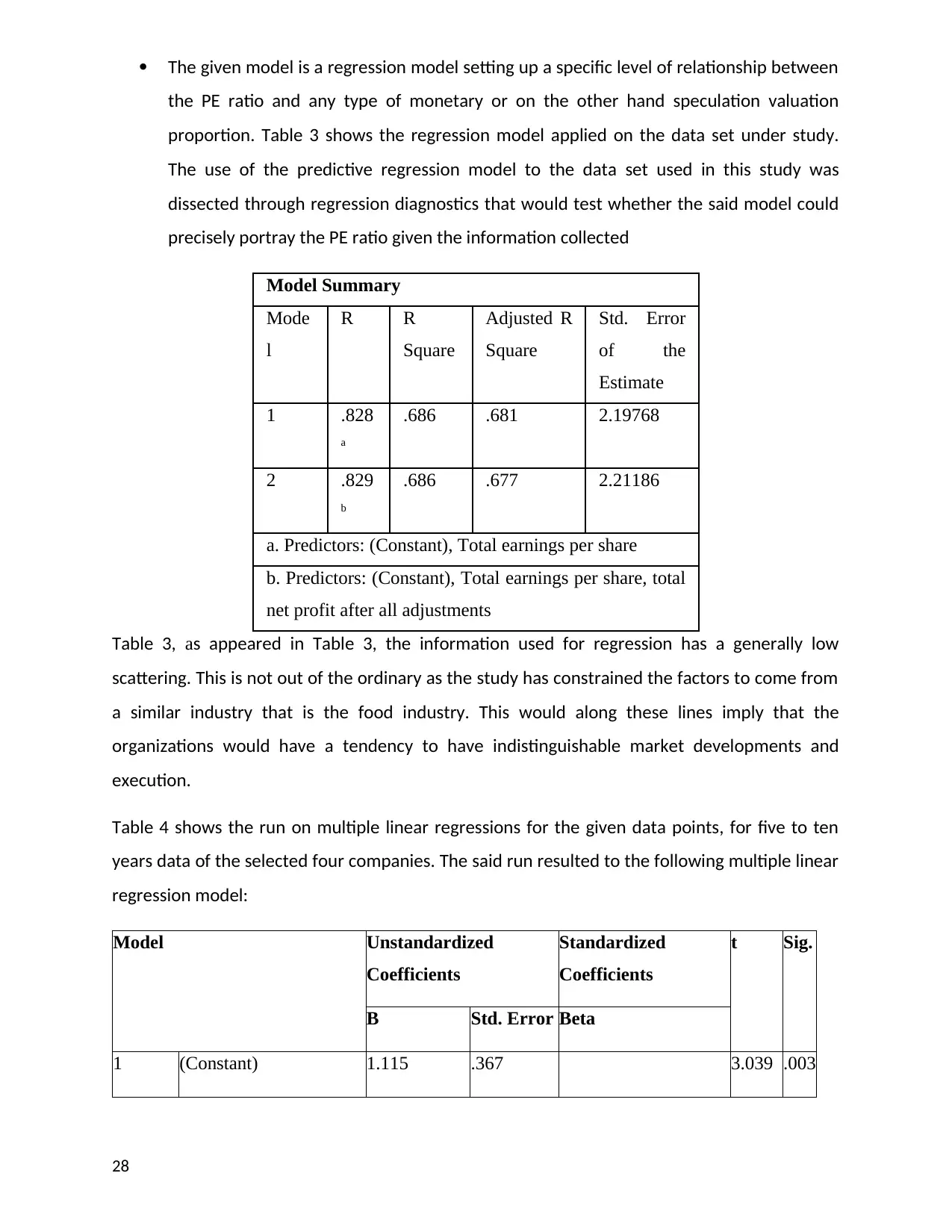
the PE ratio and any type of monetary or on the other hand speculation valuation
proportion. Table 3 shows the regression model applied on the data set under study.
The use of the predictive regression model to the data set used in this study was
dissected through regression diagnostics that would test whether the said model could
precisely portray the PE ratio given the information collected
Model Summary
Mode
l
R R
Square
Adjusted R
Square
Std. Error
of the
Estimate
1 .828
a
.686 .681 2.19768
2 .829
b
.686 .677 2.21186
a. Predictors: (Constant), Total earnings per share
b. Predictors: (Constant), Total earnings per share, total
net profit after all adjustments
Table 3, as appeared in Table 3, the information used for regression has a generally low
scattering. This is not out of the ordinary as the study has constrained the factors to come from
a similar industry that is the food industry. This would along these lines imply that the
organizations would have a tendency to have indistinguishable market developments and
execution.
Table 4 shows the run on multiple linear regressions for the given data points, for five to ten
years data of the selected four companies. The said run resulted to the following multiple linear
regression model:
Model Unstandardized
Coefficients
Standardized
Coefficients
t Sig.
B Std. Error Beta
1 (Constant) 1.115 .367 3.039 .003
28
Paraphrase This Document
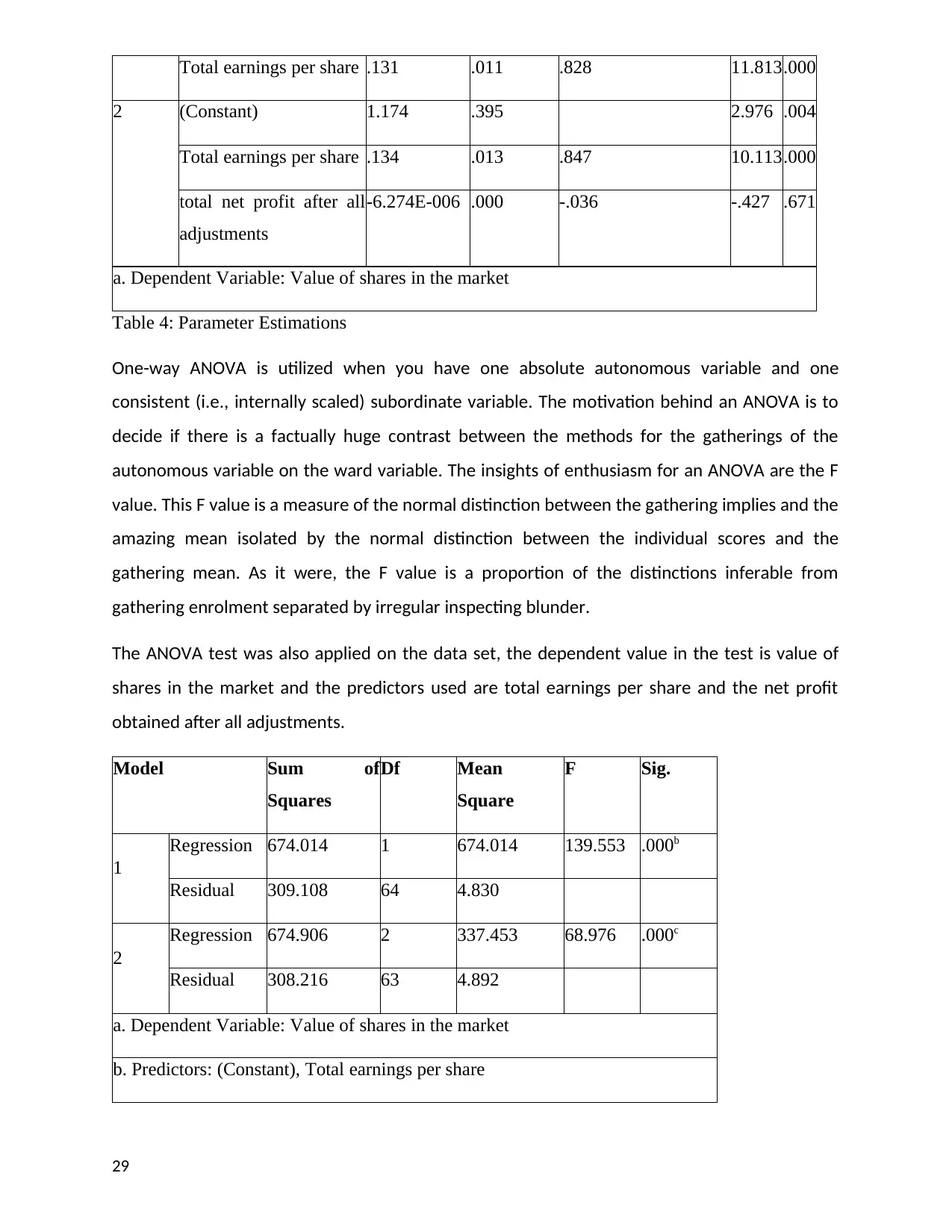
2 (Constant) 1.174 .395 2.976 .004
Total earnings per share .134 .013 .847 10.113.000
total net profit after all
adjustments
-6.274E-006 .000 -.036 -.427 .671
a. Dependent Variable: Value of shares in the market
Table 4: Parameter Estimations
One-way ANOVA is utilized when you have one absolute autonomous variable and one
consistent (i.e., internally scaled) subordinate variable. The motivation behind an ANOVA is to
decide if there is a factually huge contrast between the methods for the gatherings of the
autonomous variable on the ward variable. The insights of enthusiasm for an ANOVA are the F
value. This F value is a measure of the normal distinction between the gathering implies and the
amazing mean isolated by the normal distinction between the individual scores and the
gathering mean. As it were, the F value is a proportion of the distinctions inferable from
gathering enrolment separated by irregular inspecting blunder.
The ANOVA test was also applied on the data set, the dependent value in the test is value of
shares in the market and the predictors used are total earnings per share and the net profit
obtained after all adjustments.
Model Sum of
Squares
Df Mean
Square
F Sig.
1
Regression 674.014 1 674.014 139.553 .000b
Residual 309.108 64 4.830
2
Regression 674.906 2 337.453 68.976 .000c
Residual 308.216 63 4.892
a. Dependent Variable: Value of shares in the market
b. Predictors: (Constant), Total earnings per share
29
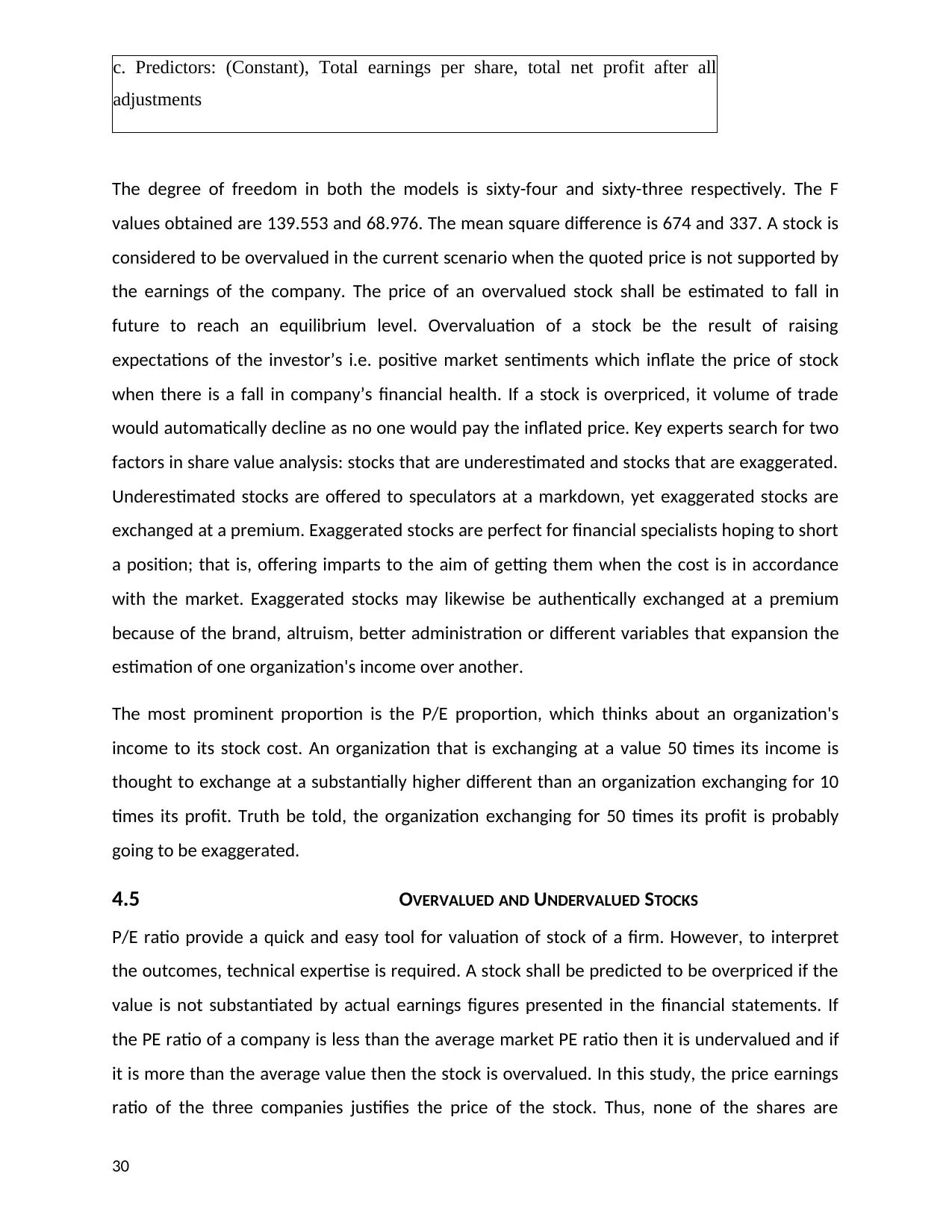
adjustments
The degree of freedom in both the models is sixty-four and sixty-three respectively. The F
values obtained are 139.553 and 68.976. The mean square difference is 674 and 337. A stock is
considered to be overvalued in the current scenario when the quoted price is not supported by
the earnings of the company. The price of an overvalued stock shall be estimated to fall in
future to reach an equilibrium level. Overvaluation of a stock be the result of raising
expectations of the investor’s i.e. positive market sentiments which inflate the price of stock
when there is a fall in company’s financial health. If a stock is overpriced, it volume of trade
would automatically decline as no one would pay the inflated price. Key experts search for two
factors in share value analysis: stocks that are underestimated and stocks that are exaggerated.
Underestimated stocks are offered to speculators at a markdown, yet exaggerated stocks are
exchanged at a premium. Exaggerated stocks are perfect for financial specialists hoping to short
a position; that is, offering imparts to the aim of getting them when the cost is in accordance
with the market. Exaggerated stocks may likewise be authentically exchanged at a premium
because of the brand, altruism, better administration or different variables that expansion the
estimation of one organization's income over another.
The most prominent proportion is the P/E proportion, which thinks about an organization's
income to its stock cost. An organization that is exchanging at a value 50 times its income is
thought to exchange at a substantially higher different than an organization exchanging for 10
times its profit. Truth be told, the organization exchanging for 50 times its profit is probably
going to be exaggerated.
4.5 OVERVALUED AND UNDERVALUED STOCKS
P/E ratio provide a quick and easy tool for valuation of stock of a firm. However, to interpret
the outcomes, technical expertise is required. A stock shall be predicted to be overpriced if the
value is not substantiated by actual earnings figures presented in the financial statements. If
the PE ratio of a company is less than the average market PE ratio then it is undervalued and if
it is more than the average value then the stock is overvalued. In this study, the price earnings
ratio of the three companies justifies the price of the stock. Thus, none of the shares are
30
⊘ This is a preview!⊘
Do you want full access?
Subscribe today to unlock all pages.

Trusted by 1+ million students worldwide
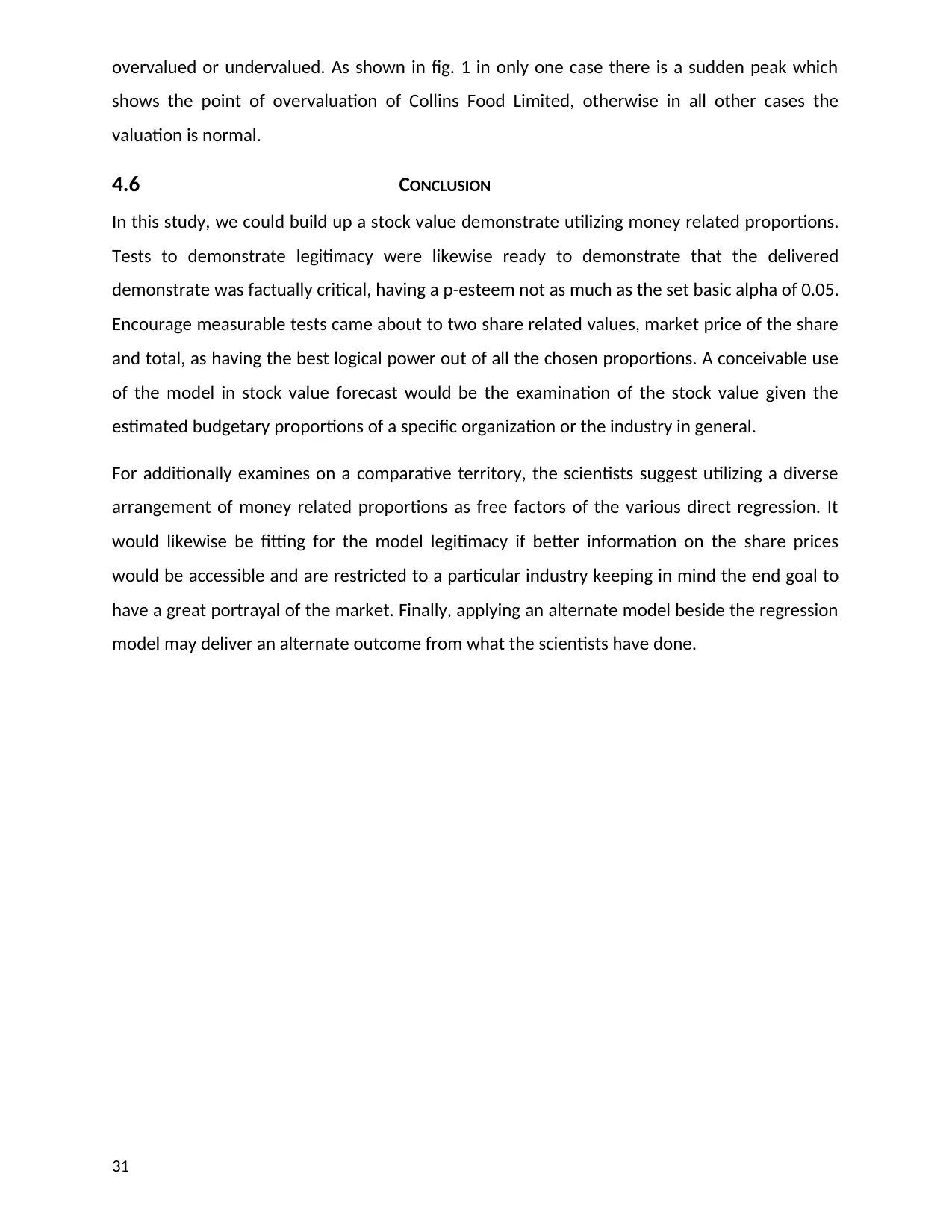
shows the point of overvaluation of Collins Food Limited, otherwise in all other cases the
valuation is normal.
4.6 CONCLUSION
In this study, we could build up a stock value demonstrate utilizing money related proportions.
Tests to demonstrate legitimacy were likewise ready to demonstrate that the delivered
demonstrate was factually critical, having a p-esteem not as much as the set basic alpha of 0.05.
Encourage measurable tests came about to two share related values, market price of the share
and total, as having the best logical power out of all the chosen proportions. A conceivable use
of the model in stock value forecast would be the examination of the stock value given the
estimated budgetary proportions of a specific organization or the industry in general.
For additionally examines on a comparative territory, the scientists suggest utilizing a diverse
arrangement of money related proportions as free factors of the various direct regression. It
would likewise be fitting for the model legitimacy if better information on the share prices
would be accessible and are restricted to a particular industry keeping in mind the end goal to
have a great portrayal of the market. Finally, applying an alternate model beside the regression
model may deliver an alternate outcome from what the scientists have done.
31
Paraphrase This Document
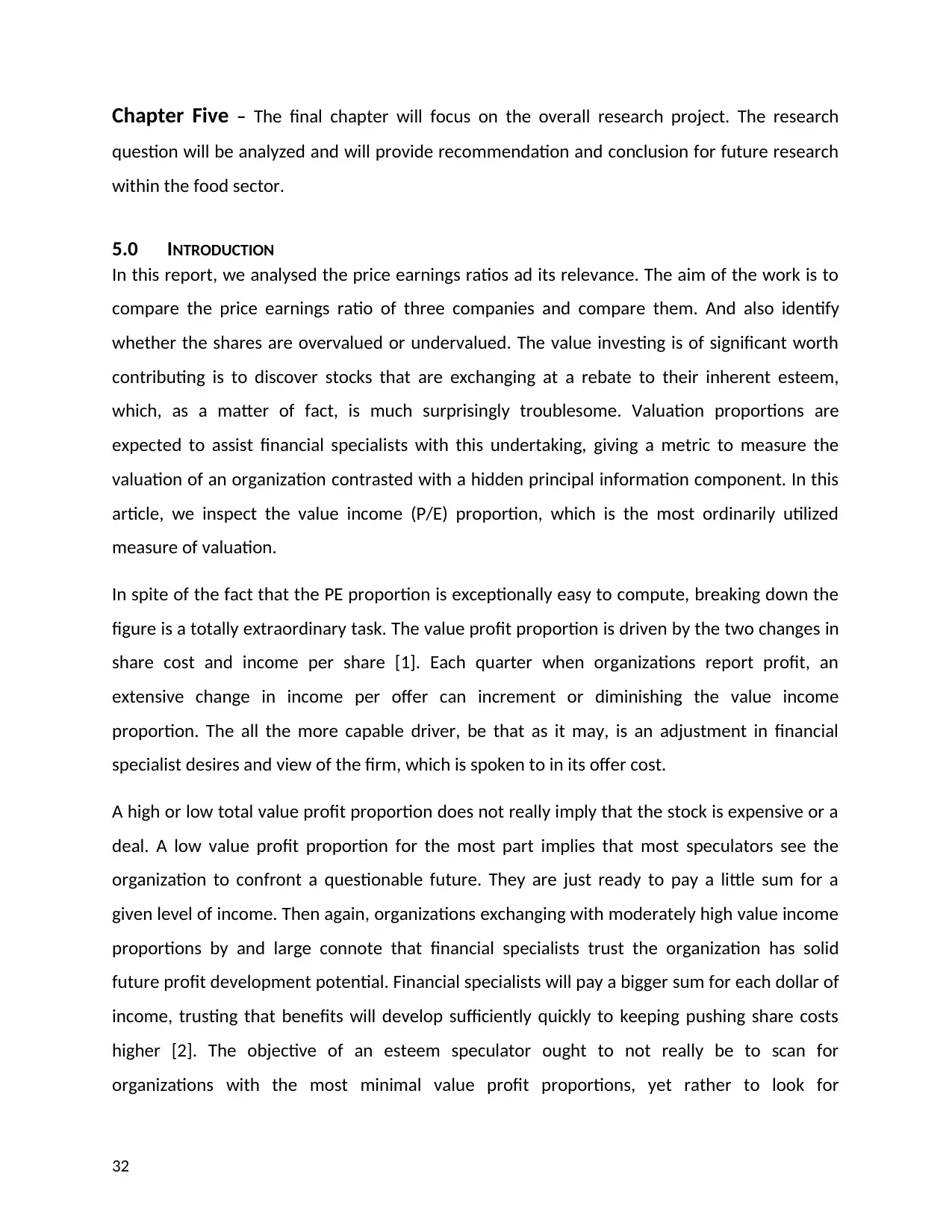
question will be analyzed and will provide recommendation and conclusion for future research
within the food sector.
5.0 INTRODUCTION
In this report, we analysed the price earnings ratios ad its relevance. The aim of the work is to
compare the price earnings ratio of three companies and compare them. And also identify
whether the shares are overvalued or undervalued. The value investing is of significant worth
contributing is to discover stocks that are exchanging at a rebate to their inherent esteem,
which, as a matter of fact, is much surprisingly troublesome. Valuation proportions are
expected to assist financial specialists with this undertaking, giving a metric to measure the
valuation of an organization contrasted with a hidden principal information component. In this
article, we inspect the value income (P/E) proportion, which is the most ordinarily utilized
measure of valuation.
In spite of the fact that the PE proportion is exceptionally easy to compute, breaking down the
figure is a totally extraordinary task. The value profit proportion is driven by the two changes in
share cost and income per share [1]. Each quarter when organizations report profit, an
extensive change in income per offer can increment or diminishing the value income
proportion. The all the more capable driver, be that as it may, is an adjustment in financial
specialist desires and view of the firm, which is spoken to in its offer cost.
A high or low total value profit proportion does not really imply that the stock is expensive or a
deal. A low value profit proportion for the most part implies that most speculators see the
organization to confront a questionable future. They are just ready to pay a little sum for a
given level of income. Then again, organizations exchanging with moderately high value income
proportions by and large connote that financial specialists trust the organization has solid
future profit development potential. Financial specialists will pay a bigger sum for each dollar of
income, trusting that benefits will develop sufficiently quickly to keeping pushing share costs
higher [2]. The objective of an esteem speculator ought to not really be to scan for
organizations with the most minimal value profit proportions, yet rather to look for
32
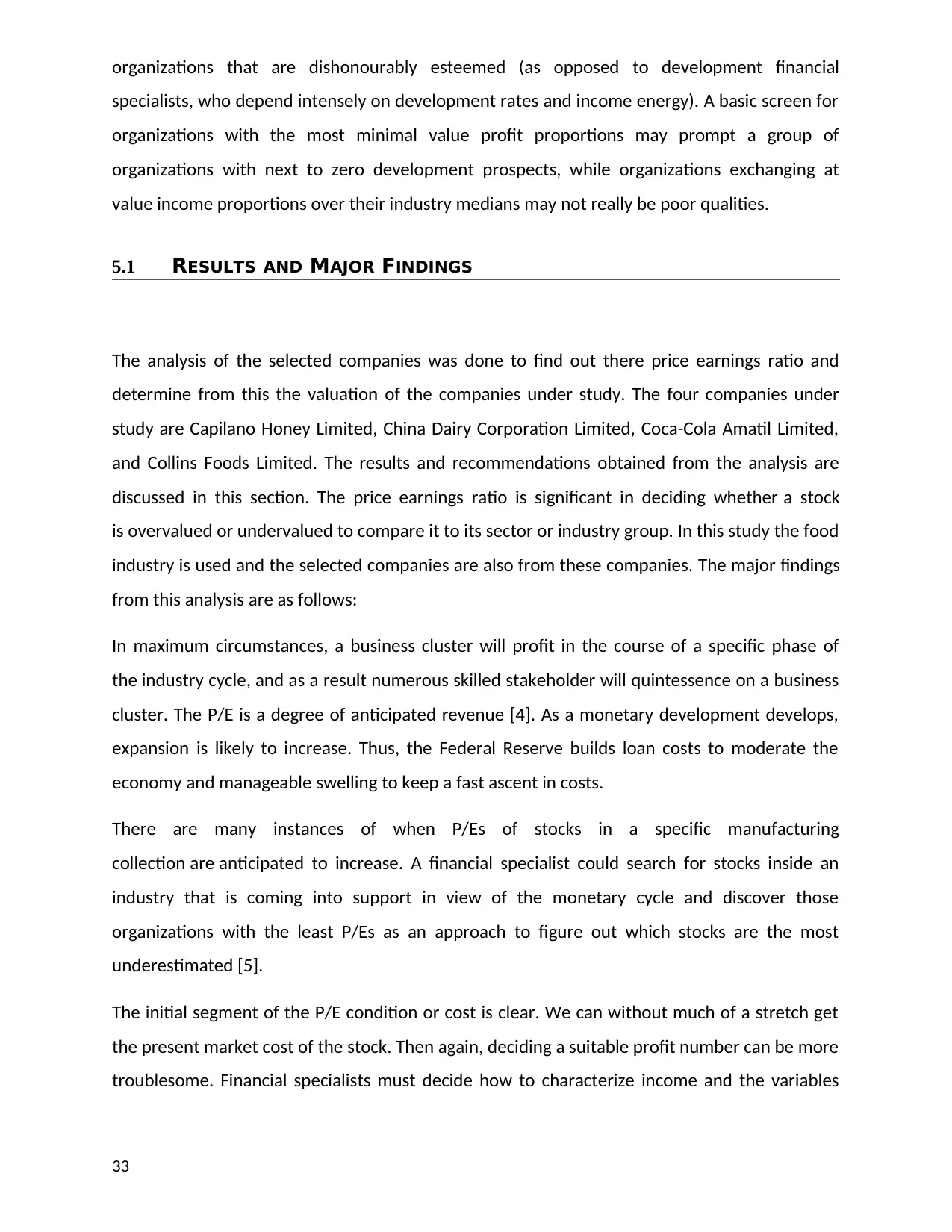
specialists, who depend intensely on development rates and income energy). A basic screen for
organizations with the most minimal value profit proportions may prompt a group of
organizations with next to zero development prospects, while organizations exchanging at
value income proportions over their industry medians may not really be poor qualities.
5.1 RESULTS AND MAJOR FINDINGS
The analysis of the selected companies was done to find out there price earnings ratio and
determine from this the valuation of the companies under study. The four companies under
study are Capilano Honey Limited, China Dairy Corporation Limited, Coca-Cola Amatil Limited,
and Collins Foods Limited. The results and recommendations obtained from the analysis are
discussed in this section. The price earnings ratio is significant in deciding whether a stock
is overvalued or undervalued to compare it to its sector or industry group. In this study the food
industry is used and the selected companies are also from these companies. The major findings
from this analysis are as follows:
In maximum circumstances, a business cluster will profit in the course of a specific phase of
the industry cycle, and as a result numerous skilled stakeholder will quintessence on a business
cluster. The P/E is a degree of anticipated revenue [4]. As a monetary development develops,
expansion is likely to increase. Thus, the Federal Reserve builds loan costs to moderate the
economy and manageable swelling to keep a fast ascent in costs.
There are many instances of when P/Es of stocks in a specific manufacturing
collection are anticipated to increase. A financial specialist could search for stocks inside an
industry that is coming into support in view of the monetary cycle and discover those
organizations with the least P/Es as an approach to figure out which stocks are the most
underestimated [5].
The initial segment of the P/E condition or cost is clear. We can without much of a stretch get
the present market cost of the stock. Then again, deciding a suitable profit number can be more
troublesome. Financial specialists must decide how to characterize income and the variables
33
⊘ This is a preview!⊘
Do you want full access?
Subscribe today to unlock all pages.

Trusted by 1+ million students worldwide
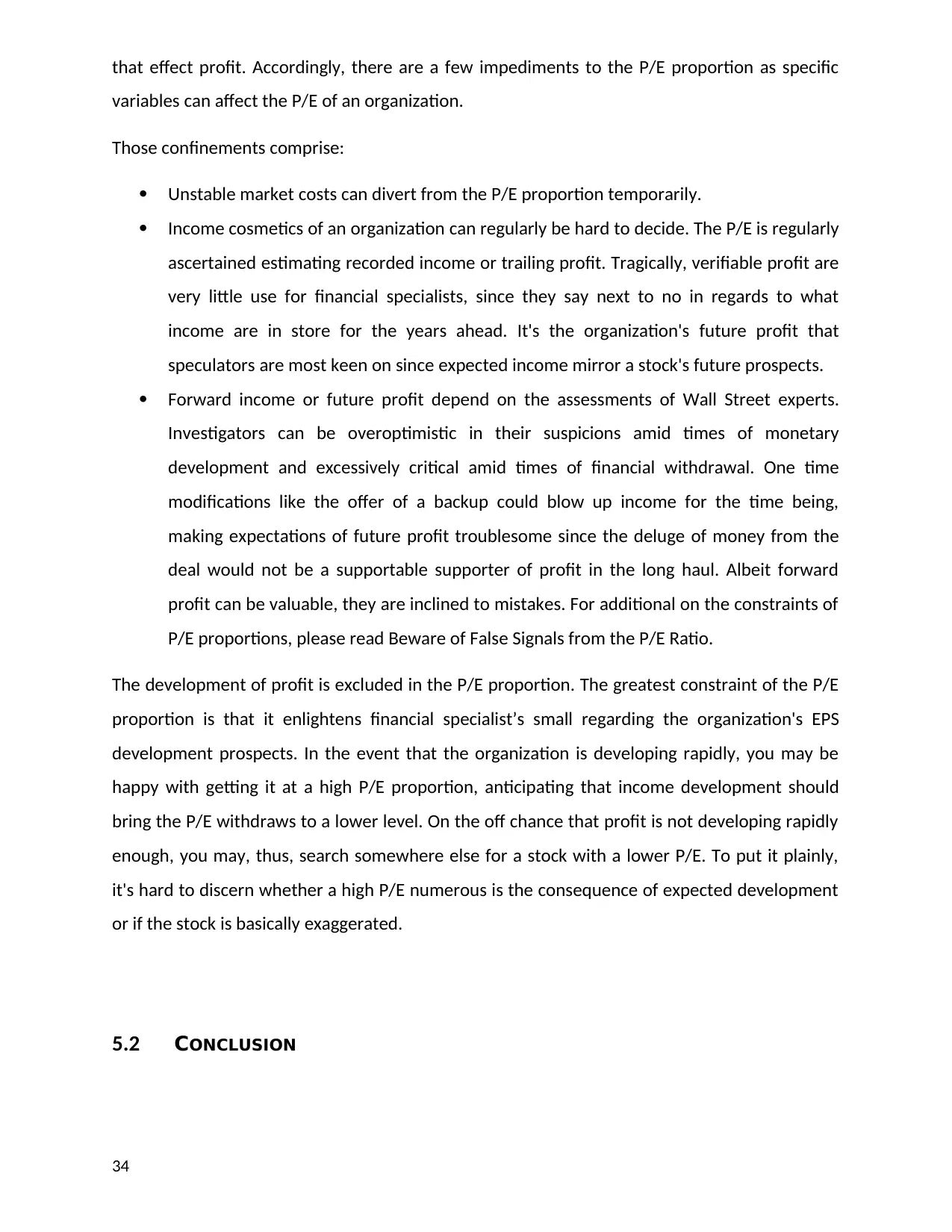
variables can affect the P/E of an organization.
Those confinements comprise:
Unstable market costs can divert from the P/E proportion temporarily.
Income cosmetics of an organization can regularly be hard to decide. The P/E is regularly
ascertained estimating recorded income or trailing profit. Tragically, verifiable profit are
very little use for financial specialists, since they say next to no in regards to what
income are in store for the years ahead. It's the organization's future profit that
speculators are most keen on since expected income mirror a stock's future prospects.
Forward income or future profit depend on the assessments of Wall Street experts.
Investigators can be overoptimistic in their suspicions amid times of monetary
development and excessively critical amid times of financial withdrawal. One time
modifications like the offer of a backup could blow up income for the time being,
making expectations of future profit troublesome since the deluge of money from the
deal would not be a supportable supporter of profit in the long haul. Albeit forward
profit can be valuable, they are inclined to mistakes. For additional on the constraints of
P/E proportions, please read Beware of False Signals from the P/E Ratio.
The development of profit is excluded in the P/E proportion. The greatest constraint of the P/E
proportion is that it enlightens financial specialist’s small regarding the organization's EPS
development prospects. In the event that the organization is developing rapidly, you may be
happy with getting it at a high P/E proportion, anticipating that income development should
bring the P/E withdraws to a lower level. On the off chance that profit is not developing rapidly
enough, you may, thus, search somewhere else for a stock with a lower P/E. To put it plainly,
it's hard to discern whether a high P/E numerous is the consequence of expected development
or if the stock is basically exaggerated.
5.2 CONCLUSION
34
Paraphrase This Document
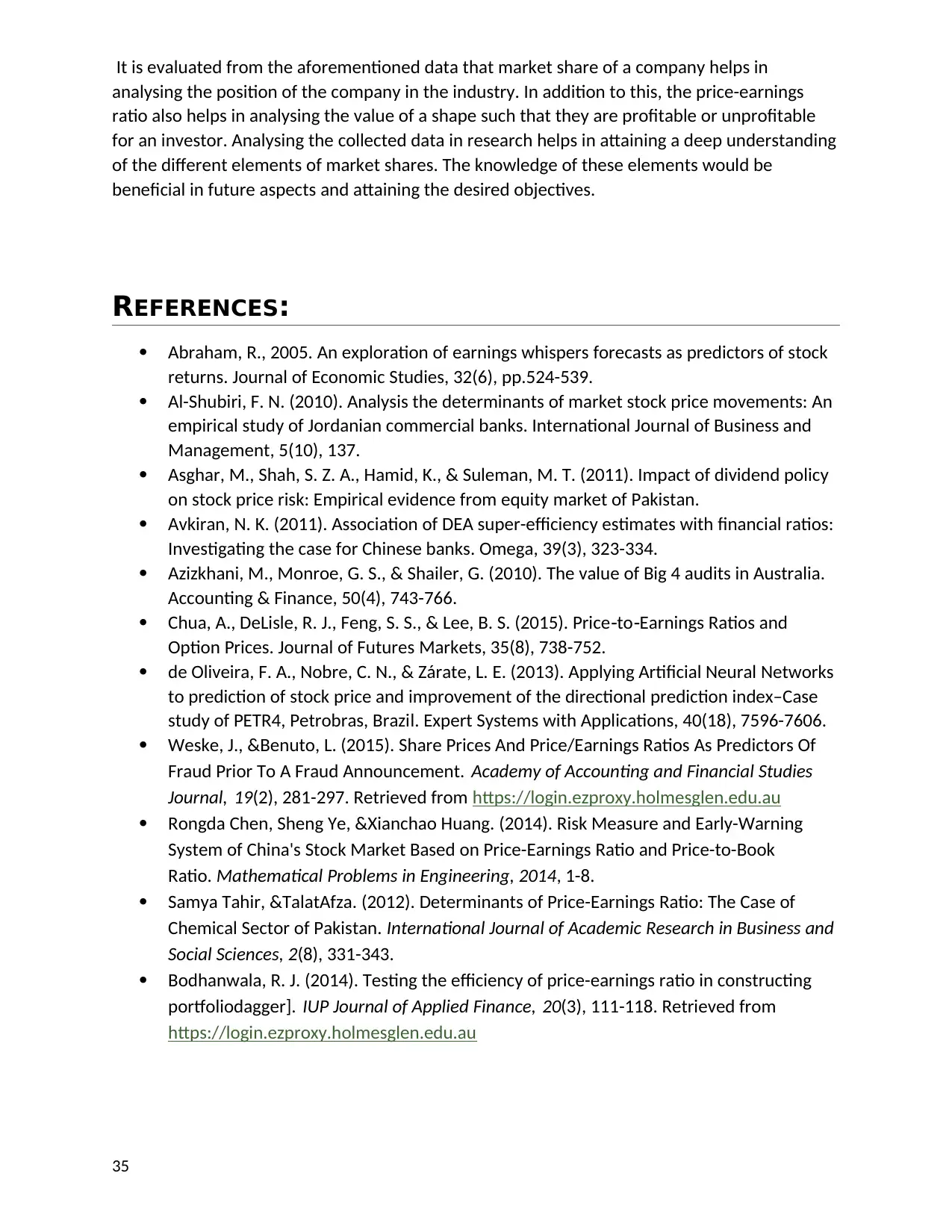
analysing the position of the company in the industry. In addition to this, the price-earnings
ratio also helps in analysing the value of a shape such that they are profitable or unprofitable
for an investor. Analysing the collected data in research helps in attaining a deep understanding
of the different elements of market shares. The knowledge of these elements would be
beneficial in future aspects and attaining the desired objectives.
REFERENCES:
Abraham, R., 2005. An exploration of earnings whispers forecasts as predictors of stock
returns. Journal of Economic Studies, 32(6), pp.524-539.
Al-Shubiri, F. N. (2010). Analysis the determinants of market stock price movements: An
empirical study of Jordanian commercial banks. International Journal of Business and
Management, 5(10), 137.
Asghar, M., Shah, S. Z. A., Hamid, K., & Suleman, M. T. (2011). Impact of dividend policy
on stock price risk: Empirical evidence from equity market of Pakistan.
Avkiran, N. K. (2011). Association of DEA super-efficiency estimates with financial ratios:
Investigating the case for Chinese banks. Omega, 39(3), 323-334.
Azizkhani, M., Monroe, G. S., & Shailer, G. (2010). The value of Big 4 audits in Australia.
Accounting & Finance, 50(4), 743-766.
Chua, A., DeLisle, R. J., Feng, S. S., & Lee, B. S. (2015). Price to Earnings Ratios and‐ ‐
Option Prices. Journal of Futures Markets, 35(8), 738-752.
de Oliveira, F. A., Nobre, C. N., & Zárate, L. E. (2013). Applying Artificial Neural Networks
to prediction of stock price and improvement of the directional prediction index–Case
study of PETR4, Petrobras, Brazil. Expert Systems with Applications, 40(18), 7596-7606.
Weske, J., &Benuto, L. (2015). Share Prices And Price/Earnings Ratios As Predictors Of
Fraud Prior To A Fraud Announcement. Academy of Accounting and Financial Studies
Journal, 19(2), 281-297. Retrieved from https://login.ezproxy.holmesglen.edu.au
Rongda Chen, Sheng Ye, &Xianchao Huang. (2014). Risk Measure and Early-Warning
System of China's Stock Market Based on Price-Earnings Ratio and Price-to-Book
Ratio. Mathematical Problems in Engineering, 2014, 1-8.
Samya Tahir, &TalatAfza. (2012). Determinants of Price-Earnings Ratio: The Case of
Chemical Sector of Pakistan. International Journal of Academic Research in Business and
Social Sciences, 2(8), 331-343.
Bodhanwala, R. J. (2014). Testing the efficiency of price-earnings ratio in constructing
portfoliodagger]. IUP Journal of Applied Finance, 20(3), 111-118. Retrieved from
https://login.ezproxy.holmesglen.edu.au
35

earnings growth ratios used by bottom-up investors. Applied Financial
Economics, 23(22), 1745-1754. doi:10.1080/09603107.2013.848028
Dudney, D. M., Jirasakuldech, B., Zorn, T., &Emekter, R. (2015). Do residual earnings
price ratios explain cross-sectional variations in stock returns?Managerial
Finance, 41(7), 692-713. Retrieved from https://login.ezproxy.holmesglen.edu.au
Jewell, J. J., &Mankin, J. A. (2016). What Is Your Eps? Issues In Computing And
Interpreting Earnings Per Share. Academy of Accounting and Financial Studies
Journal, 20(3), 48-61. Retrieved from https://login.ezproxy.holmesglen.edu.au
Robbetze, N., de Villiers, R., &Harmse, L. (2017). The effect of earnings per share
categories on share price behavior: Some south africanevidence.Journal of Applied
Business Research, 33(1), 141-152.
doi:http://dx.doi.org.ezproxy.holmesglen.edu.au/10.19030/jabr.v33i1.9886
Francisco Sousa Fernández, &María Mercedes Carro Arana. (2011). Empirical Analysis Of
The Impact Of Comprehensive Income On Basic Earnings Per Share For Spanish
Companies Listed On Madrid Stock Exchange. International Business & Economics
Research Journal, 8(6)
Ferrer, R. C., & Mallari, N. C. (2011). Speculative And Pure Risks: Their Impact On Firms'
Earnings Per Share. Journal of International Business Research, 10(1), 115-136.
Retrieved from https://login.ezproxy.holmesglen.edu.au
Bhatt, P., Dr, & Sumangala, J. K. (2012). Impact of earnings per share on market value of
an equity share: An empirical study in indian capital market. Journal of Finance,
Accounting and Management, 3(2), 1-14. Retrieved from
https://login.ezproxy.holmesglen.edu.au
Gil-alana, L., &Peláez, R.,F. (2008). The persistence of earnings per share.Review of
Quantitative Finance and Accounting, 31(4), 425-439.
doi:http://dx.doi.org.ezproxy.holmesglen.edu.au/10.1007/s11156-007-0077-0
Wei, J., & Wang, L. (2009). Improving earnings per share: An illusory motive in stock
repurchases. International Journal of Business and Economics, 8(3), 243-247. Retrieved
from https://login.ezproxy.holmesglen.edu.au
Peláez, R. F. (2007). Earnings per Share: Stylized Facts and New Paradigms. Journal Of
Behavioral Finance, 8(4), 198-208. doi:10.1080/15427560701698801
Basu, S. (1977). Investment performance of common stocks in relation to their price-
earnings ratios: A test of the efficient market hypothesis. The Journal of Finance, 32(3),
663–682.
Fisher, K. L., &Statman, M. (2000). Cognitive biases in market forecasts. The Journal of
Portfolio Management, 27(1), 72–81
Siegel, J. (1995). The nifty-fifty revisited: Do growth stocks ultimately justify their price?
The Journal of Portfolio Management, 21(4), 8–20.
36
⊘ This is a preview!⊘
Do you want full access?
Subscribe today to unlock all pages.

Trusted by 1+ million students worldwide
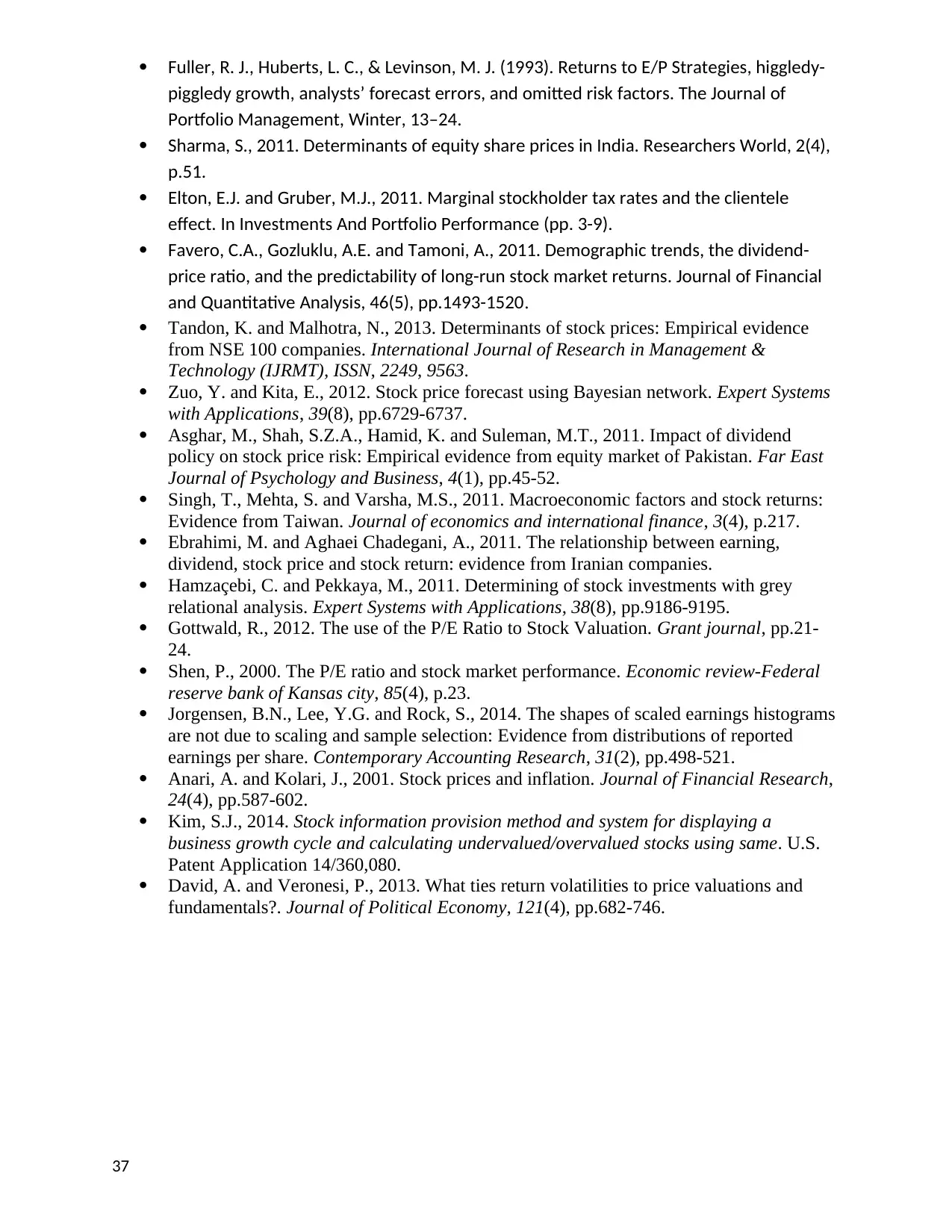
piggledy growth, analysts’ forecast errors, and omitted risk factors. The Journal of
Portfolio Management, Winter, 13–24.
Sharma, S., 2011. Determinants of equity share prices in India. Researchers World, 2(4),
p.51.
Elton, E.J. and Gruber, M.J., 2011. Marginal stockholder tax rates and the clientele
effect. In Investments And Portfolio Performance (pp. 3-9).
Favero, C.A., Gozluklu, A.E. and Tamoni, A., 2011. Demographic trends, the dividend-
price ratio, and the predictability of long-run stock market returns. Journal of Financial
and Quantitative Analysis, 46(5), pp.1493-1520.
Tandon, K. and Malhotra, N., 2013. Determinants of stock prices: Empirical evidence
from NSE 100 companies. International Journal of Research in Management &
Technology (IJRMT), ISSN, 2249, 9563.
Zuo, Y. and Kita, E., 2012. Stock price forecast using Bayesian network. Expert Systems
with Applications, 39(8), pp.6729-6737.
Asghar, M., Shah, S.Z.A., Hamid, K. and Suleman, M.T., 2011. Impact of dividend
policy on stock price risk: Empirical evidence from equity market of Pakistan. Far East
Journal of Psychology and Business, 4(1), pp.45-52.
Singh, T., Mehta, S. and Varsha, M.S., 2011. Macroeconomic factors and stock returns:
Evidence from Taiwan. Journal of economics and international finance, 3(4), p.217.
Ebrahimi, M. and Aghaei Chadegani, A., 2011. The relationship between earning,
dividend, stock price and stock return: evidence from Iranian companies.
Hamzaçebi, C. and Pekkaya, M., 2011. Determining of stock investments with grey
relational analysis. Expert Systems with Applications, 38(8), pp.9186-9195.
Gottwald, R., 2012. The use of the P/E Ratio to Stock Valuation. Grant journal, pp.21-
24.
Shen, P., 2000. The P/E ratio and stock market performance. Economic review-Federal
reserve bank of Kansas city, 85(4), p.23.
Jorgensen, B.N., Lee, Y.G. and Rock, S., 2014. The shapes of scaled earnings histograms
are not due to scaling and sample selection: Evidence from distributions of reported
earnings per share. Contemporary Accounting Research, 31(2), pp.498-521.
Anari, A. and Kolari, J., 2001. Stock prices and inflation. Journal of Financial Research,
24(4), pp.587-602.
Kim, S.J., 2014. Stock information provision method and system for displaying a
business growth cycle and calculating undervalued/overvalued stocks using same. U.S.
Patent Application 14/360,080.
David, A. and Veronesi, P., 2013. What ties return volatilities to price valuations and
fundamentals?. Journal of Political Economy, 121(4), pp.682-746.
37
Related Documents
Your All-in-One AI-Powered Toolkit for Academic Success.
+13062052269
info@desklib.com
Available 24*7 on WhatsApp / Email
![[object Object]](/_next/static/media/star-bottom.7253800d.svg)
© 2024 | Zucol Services PVT LTD | All rights reserved.





